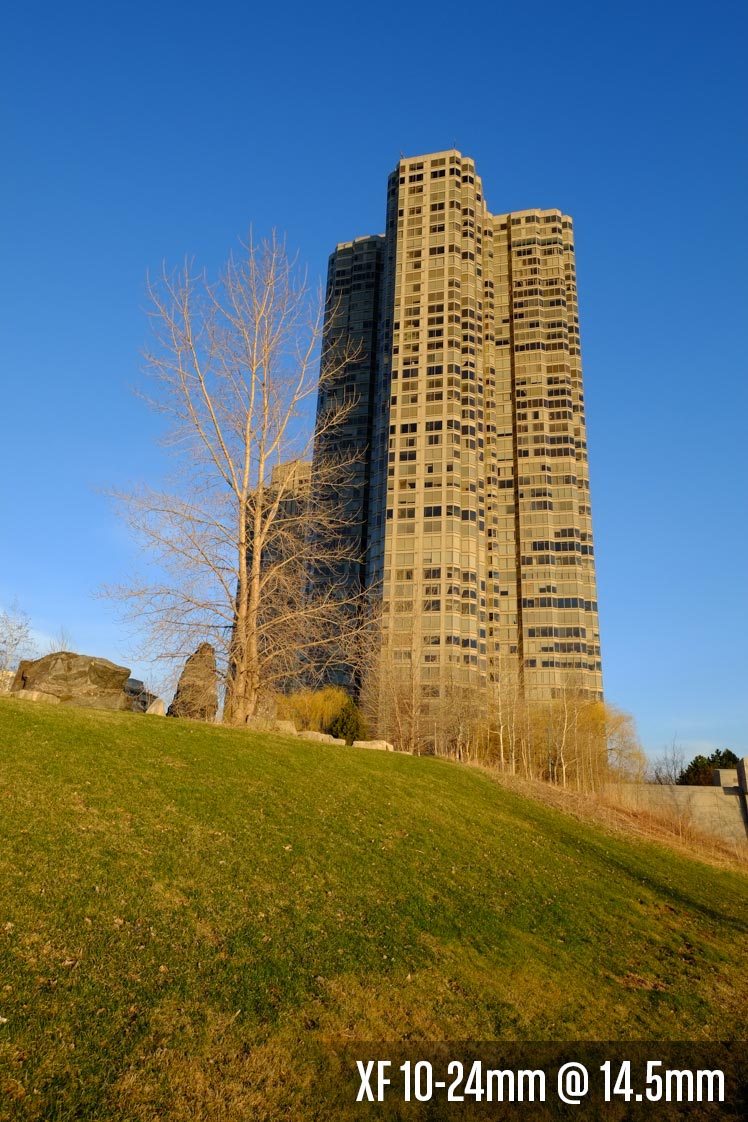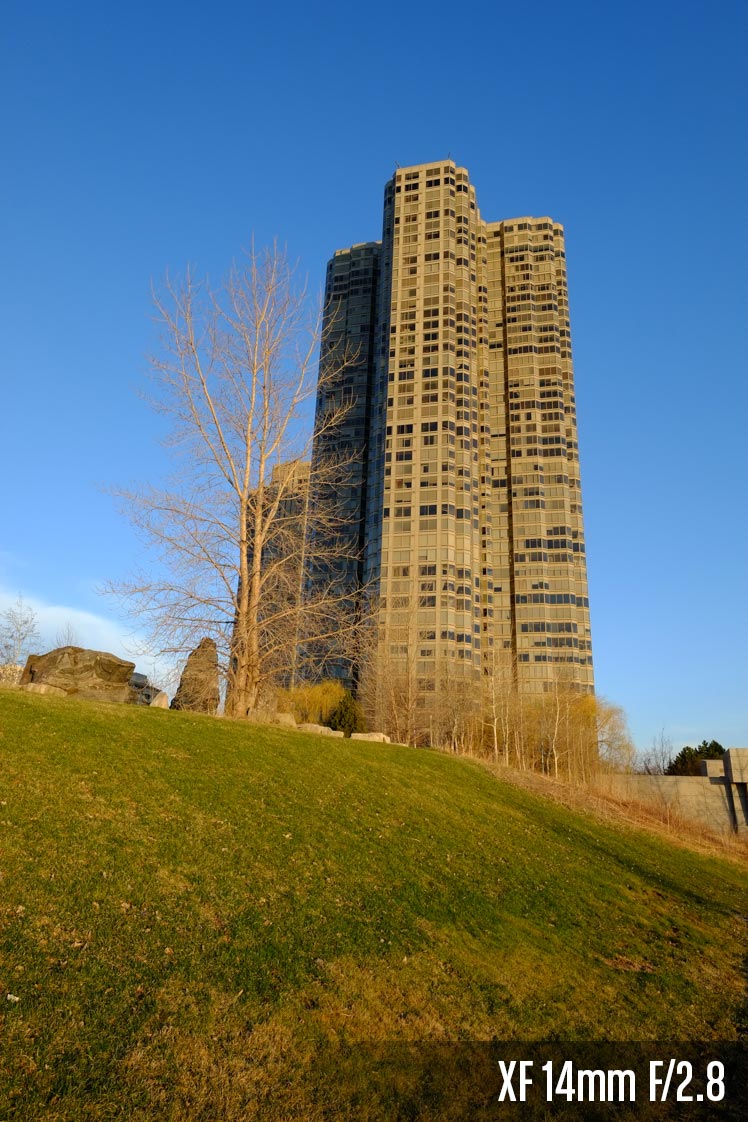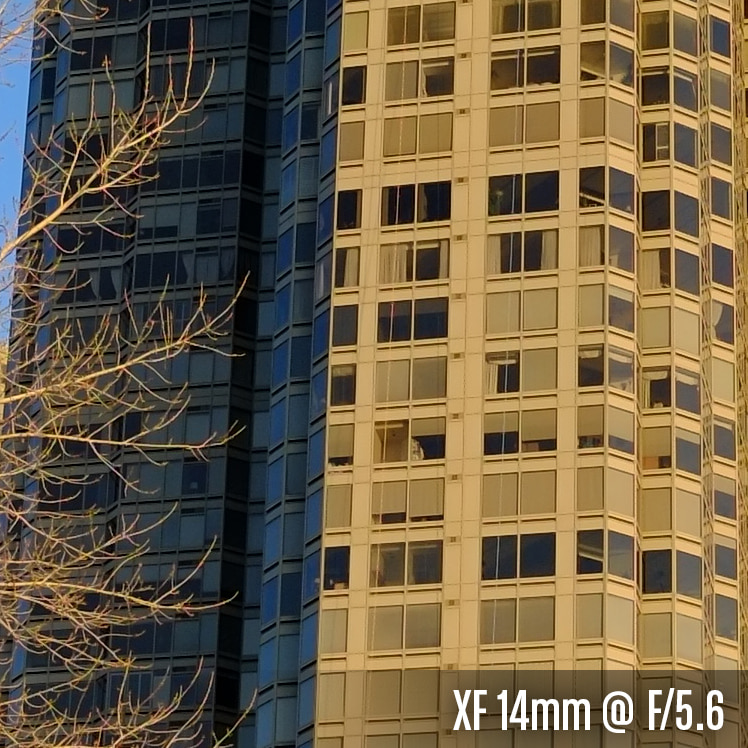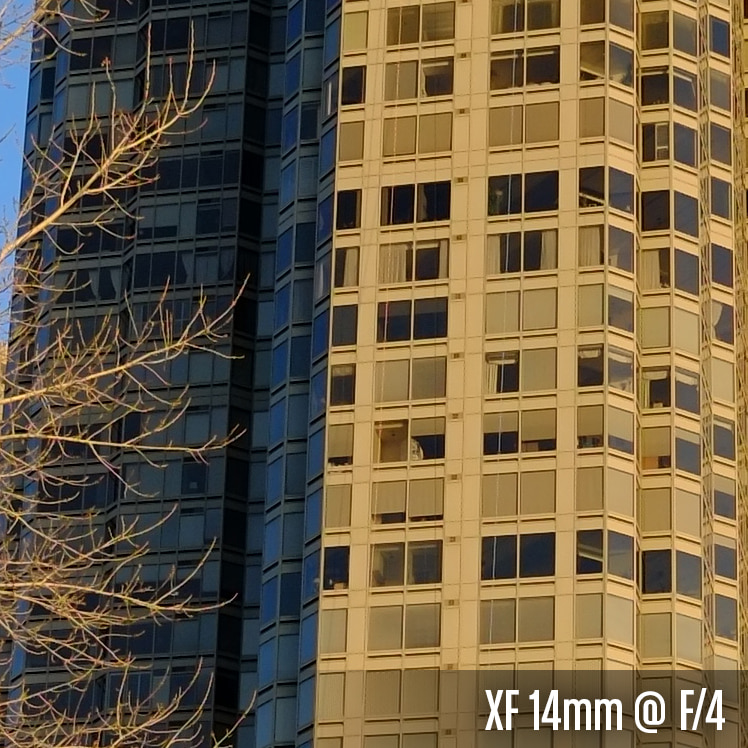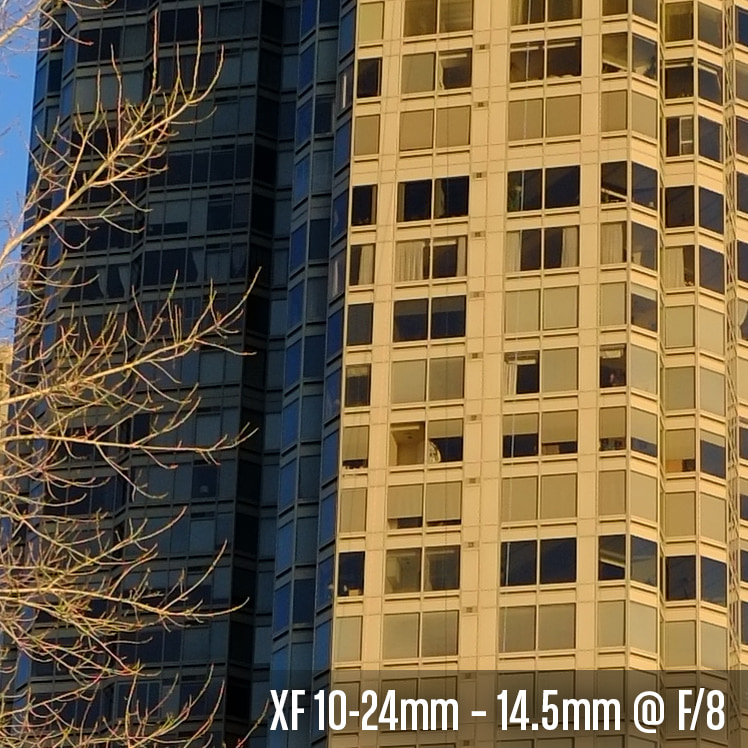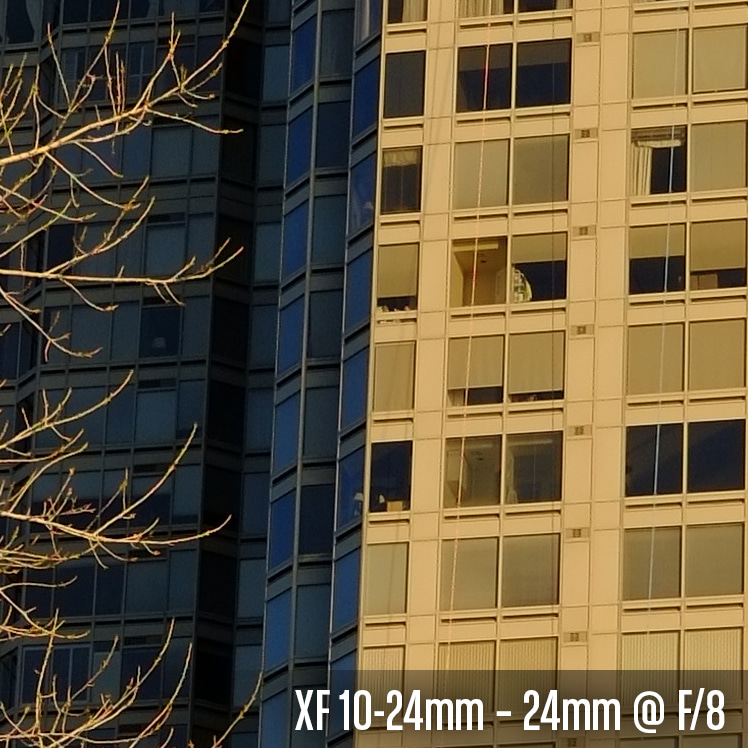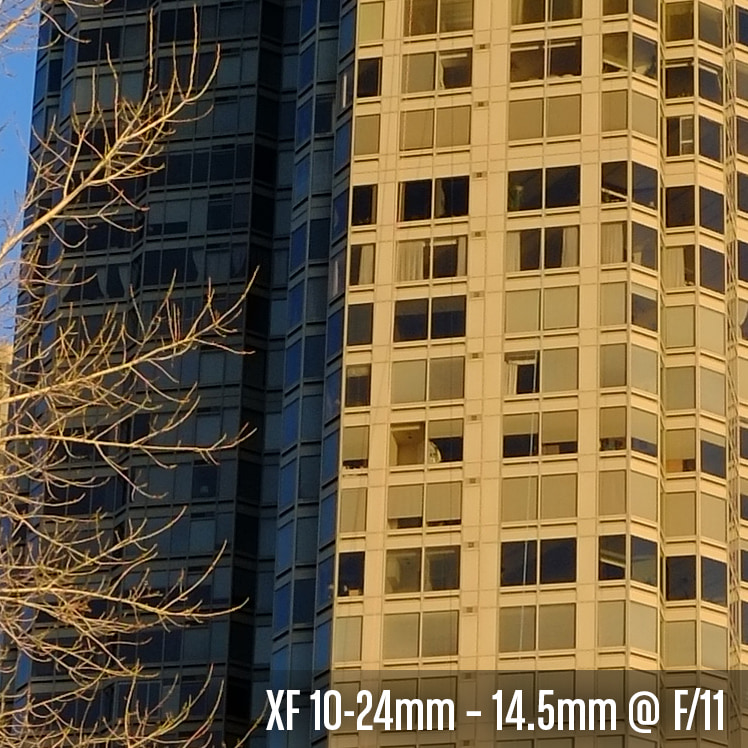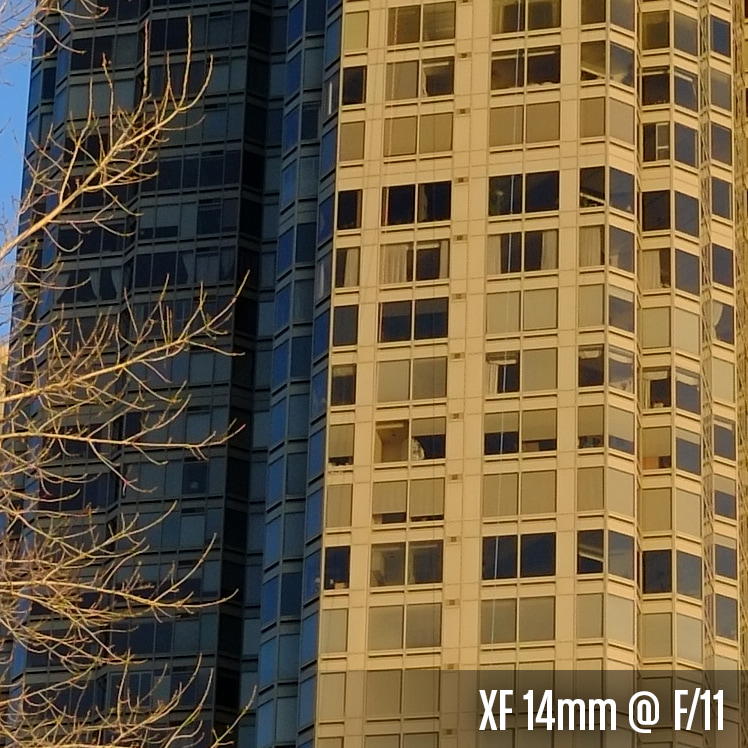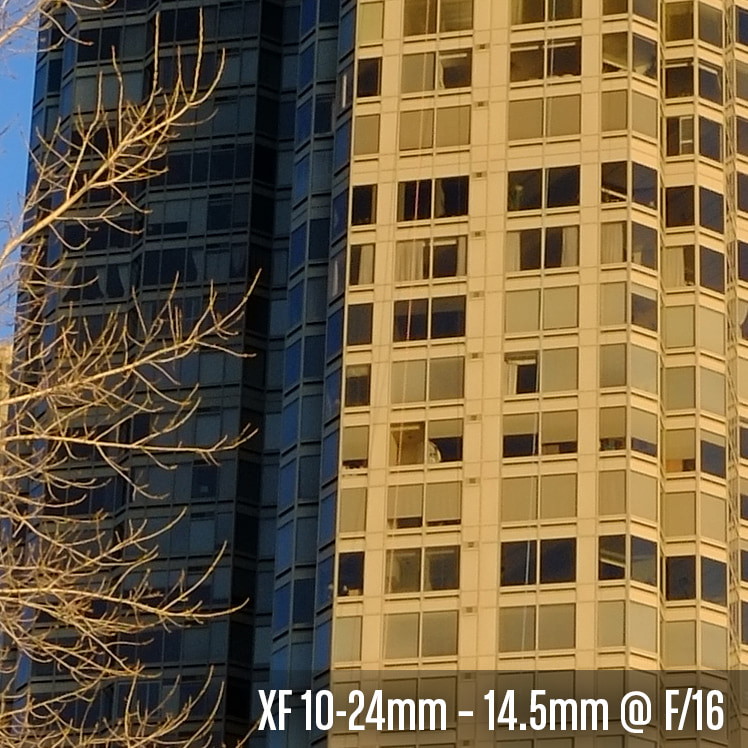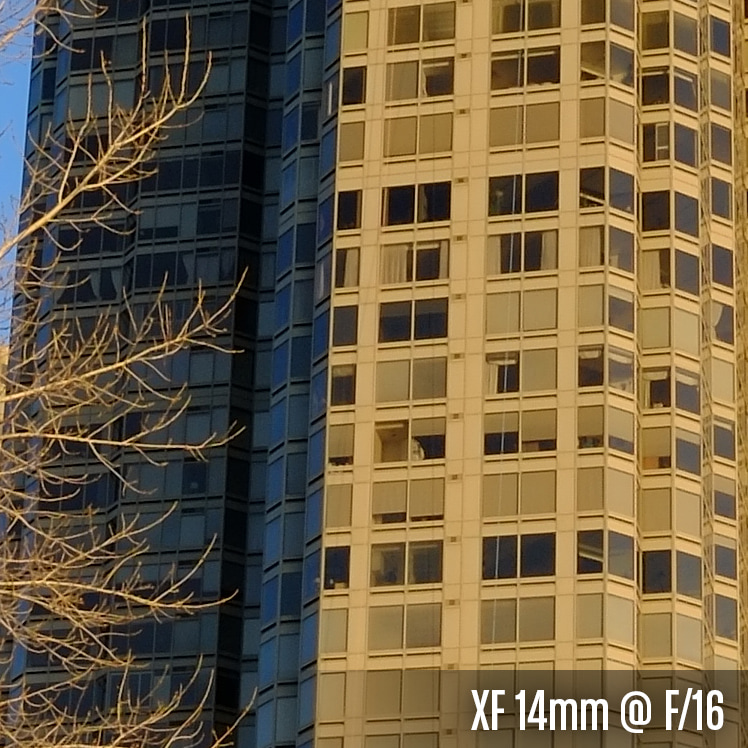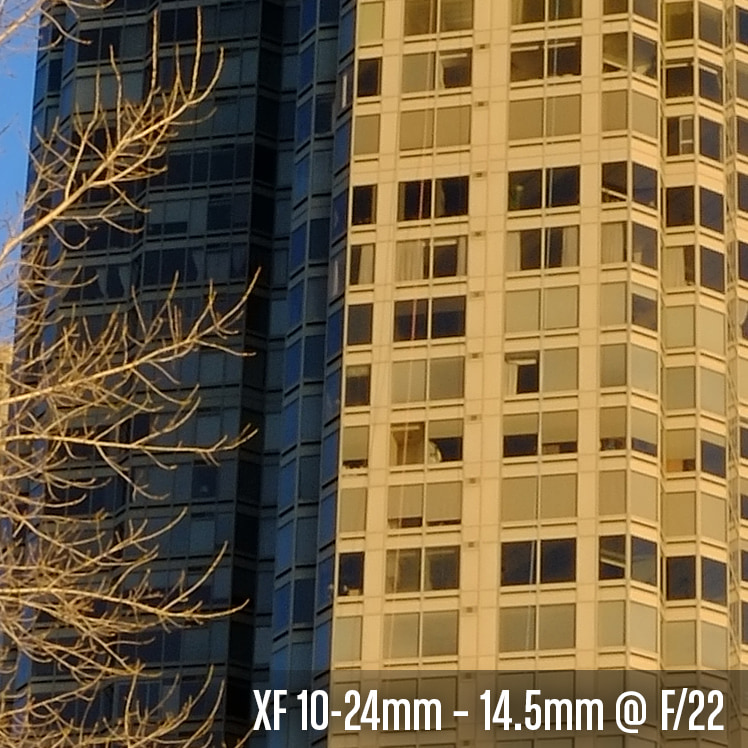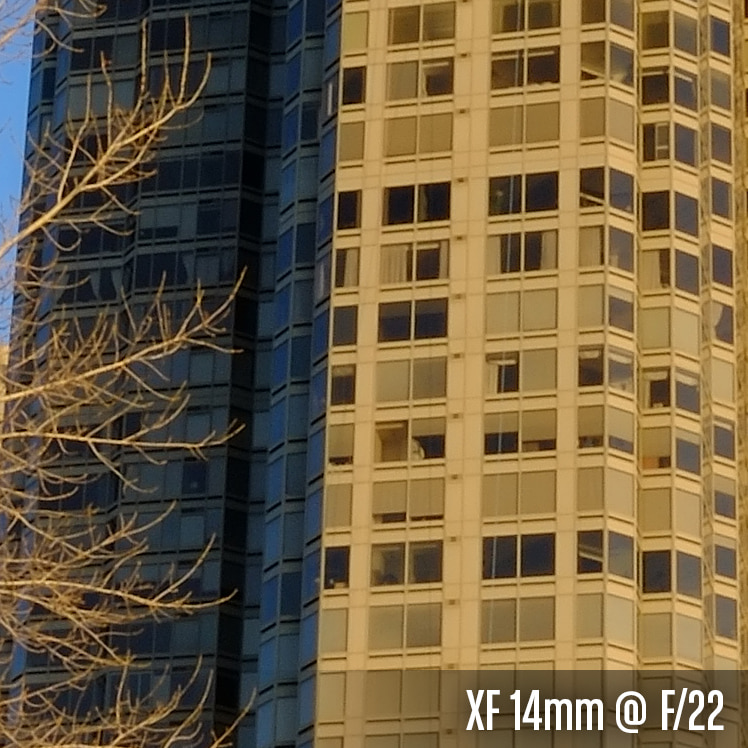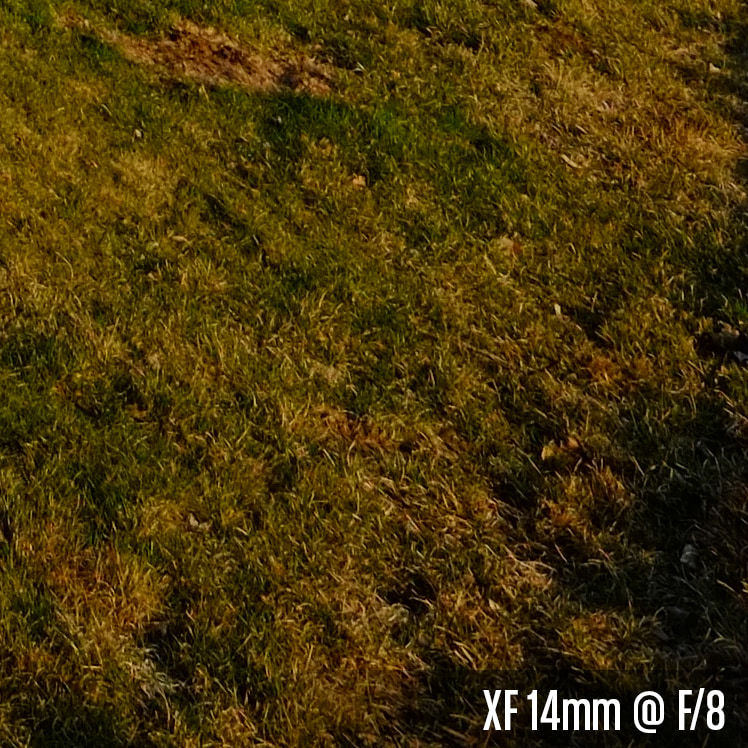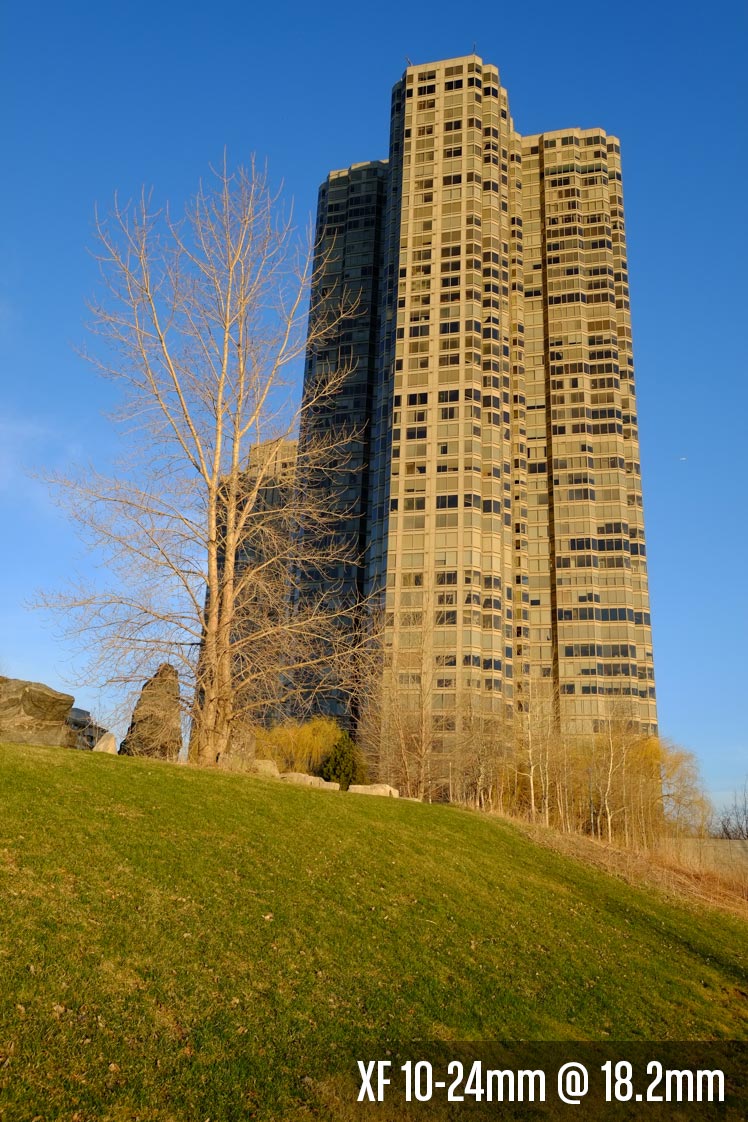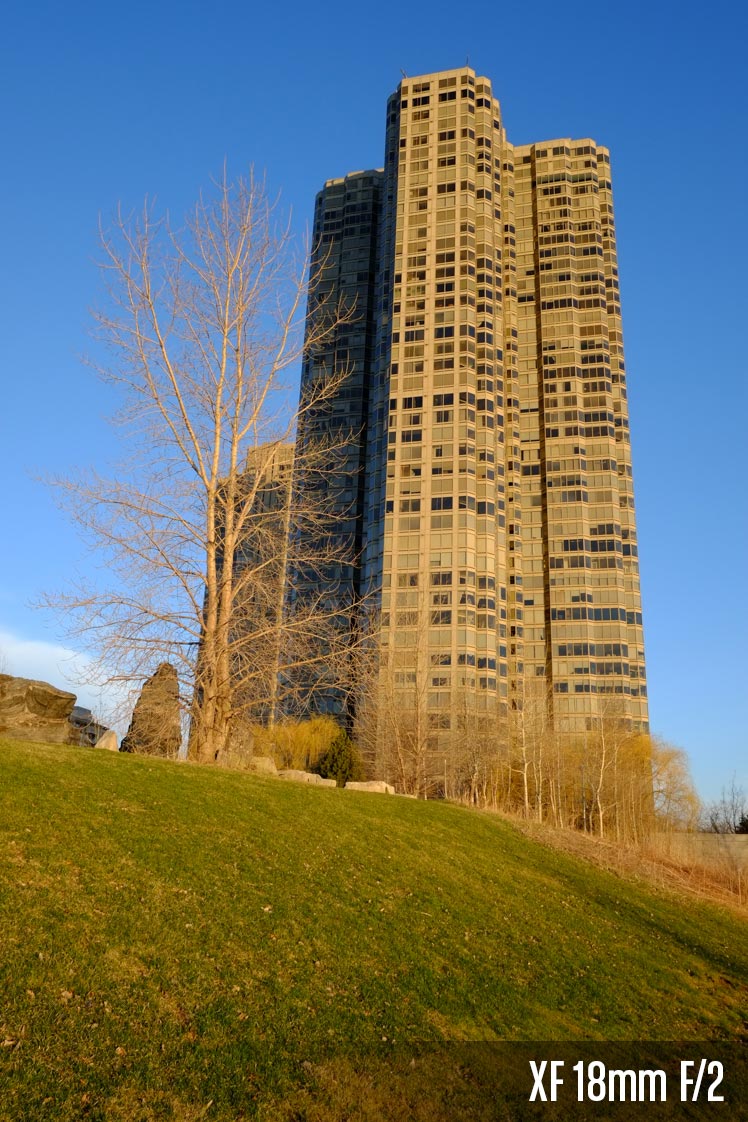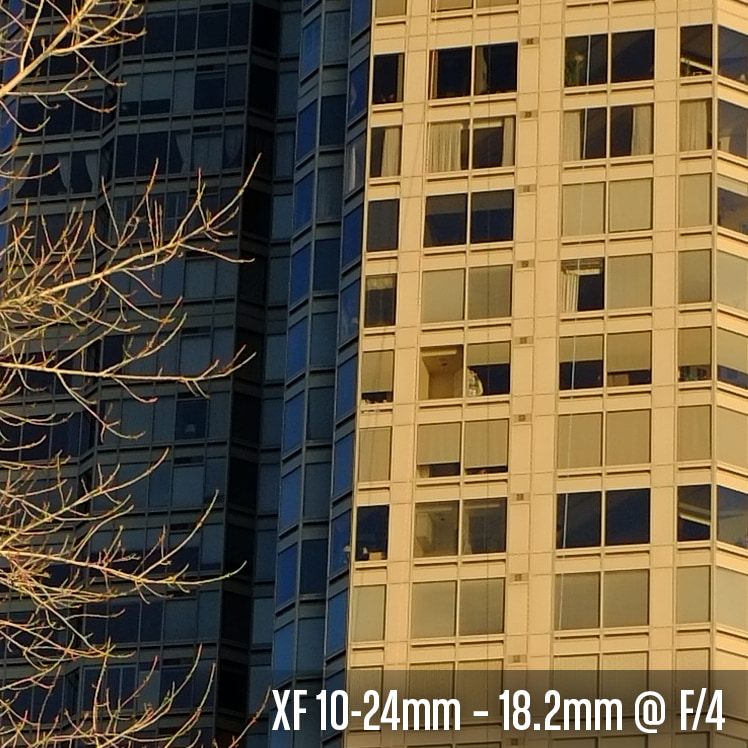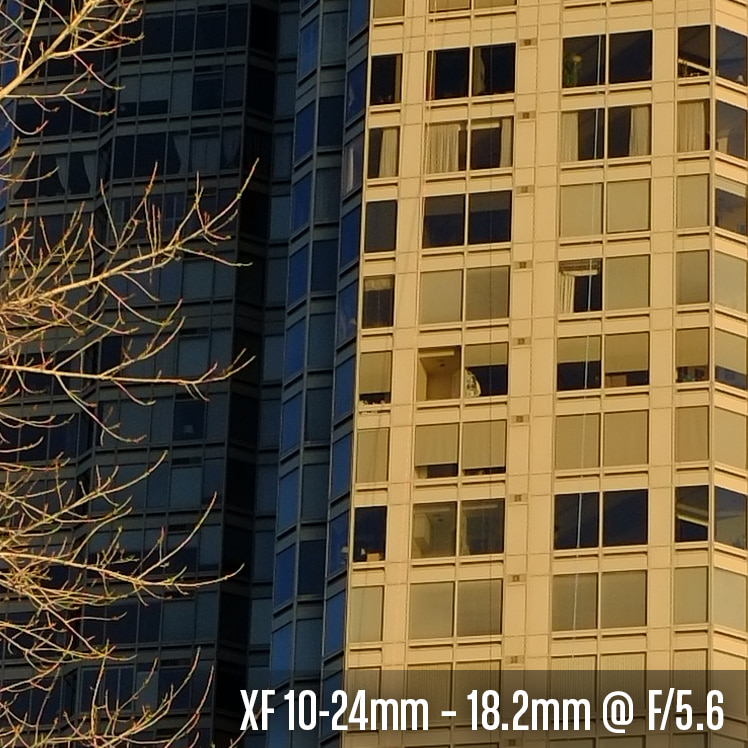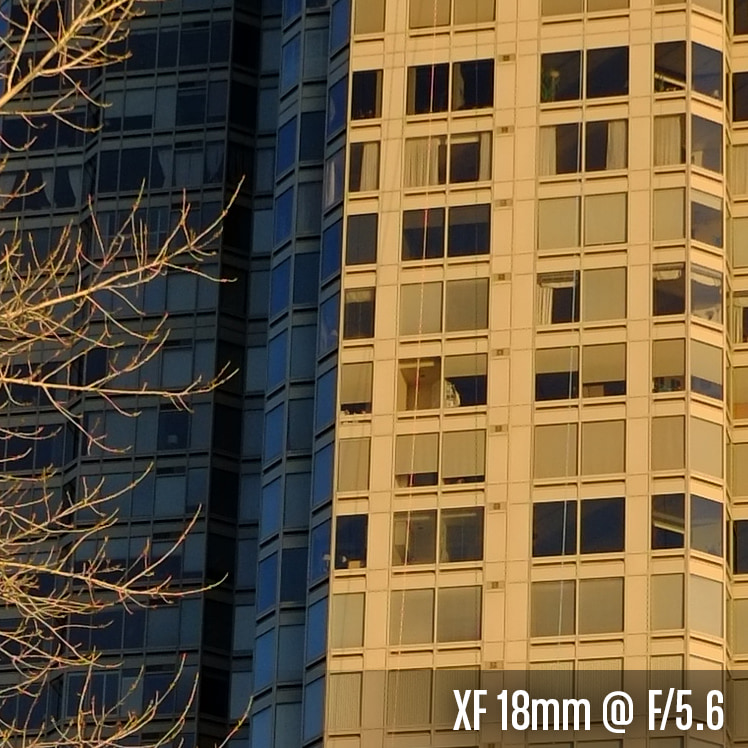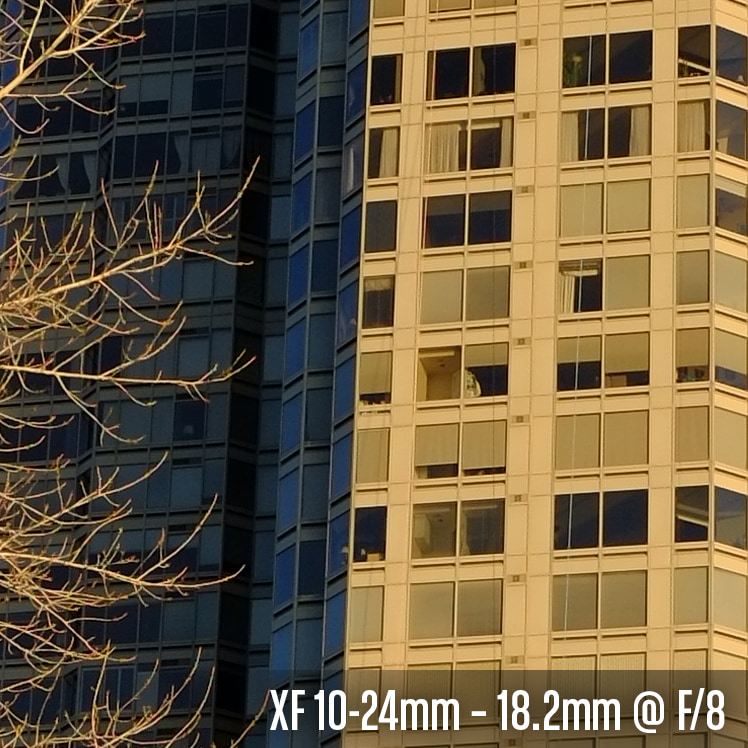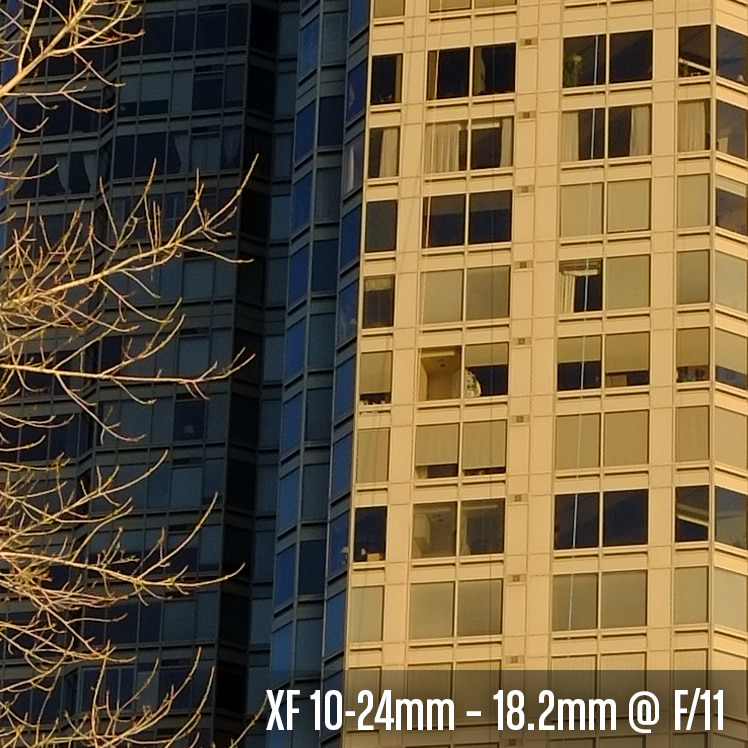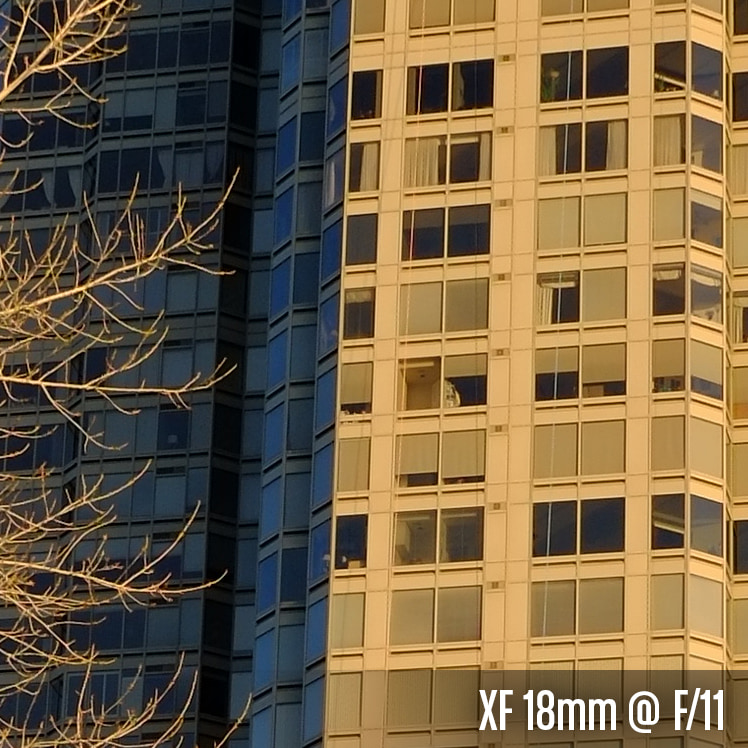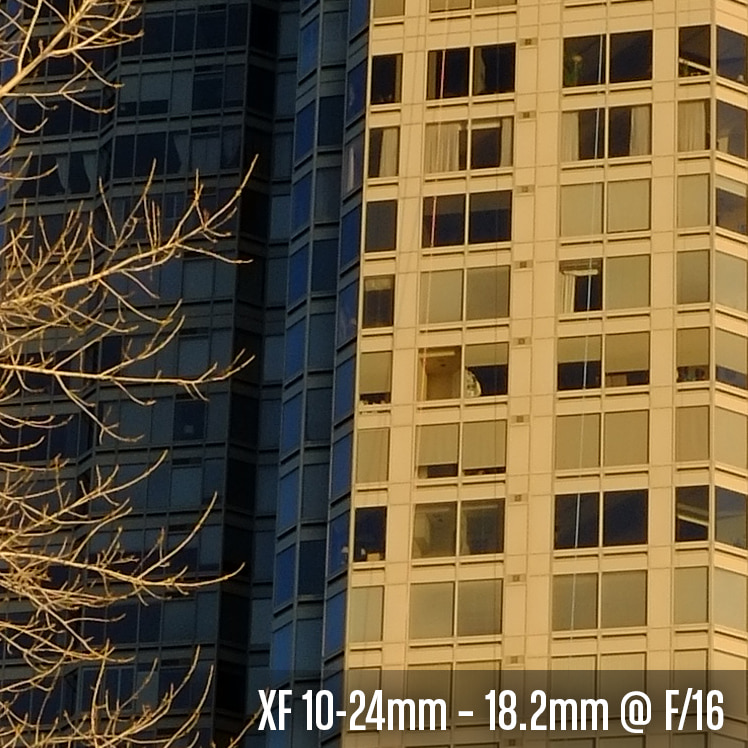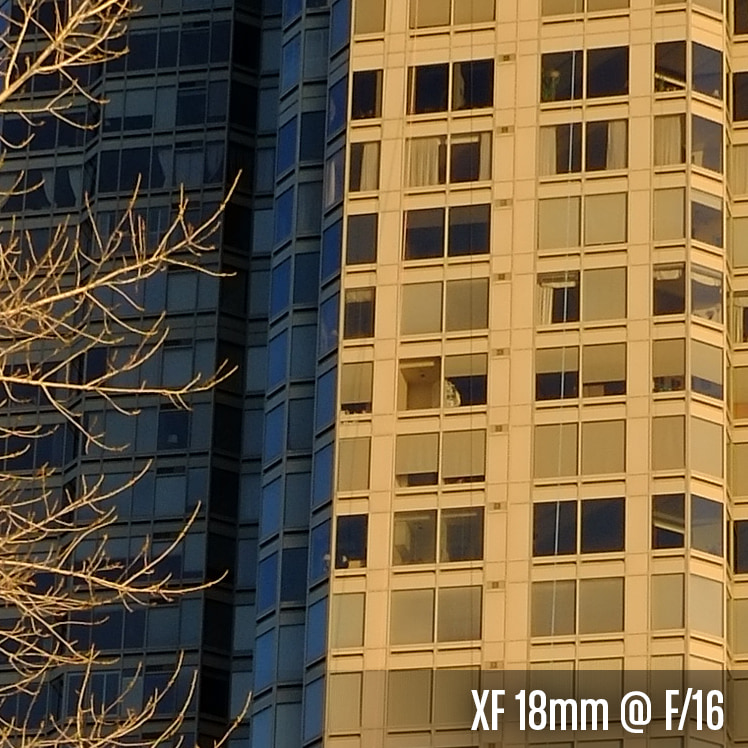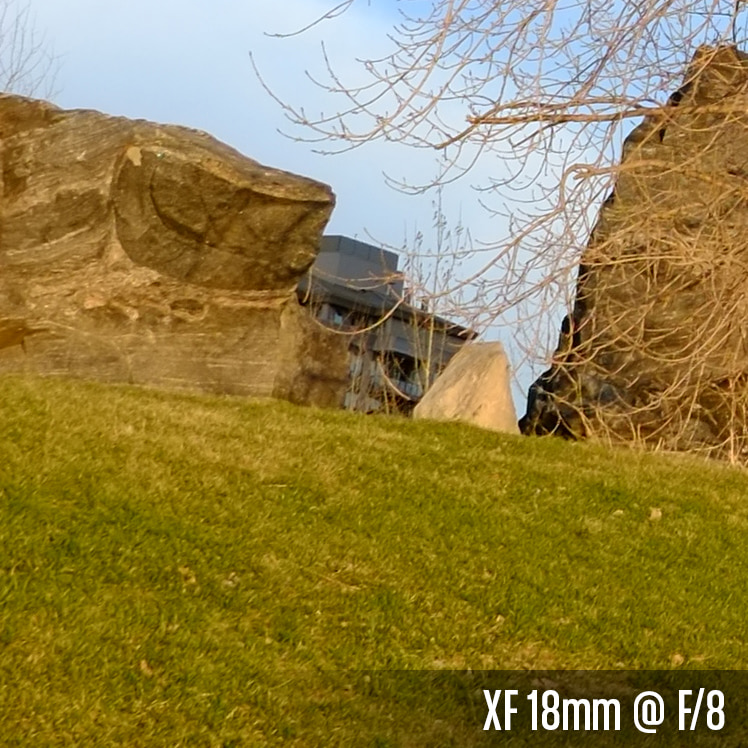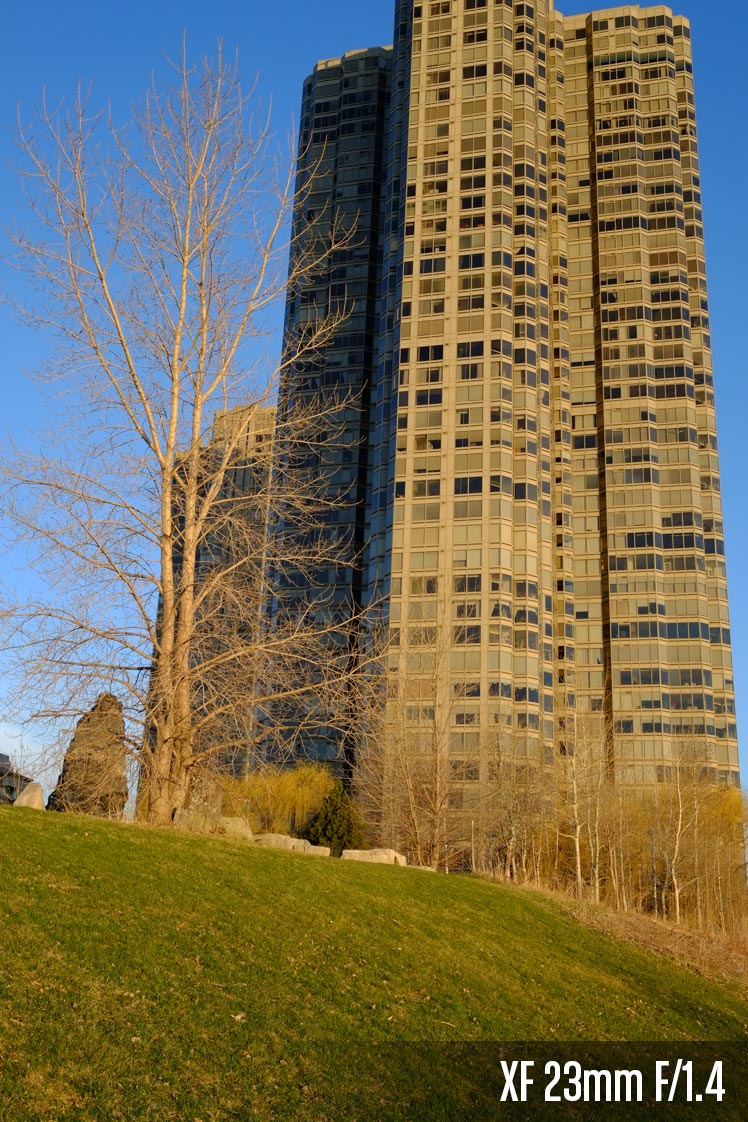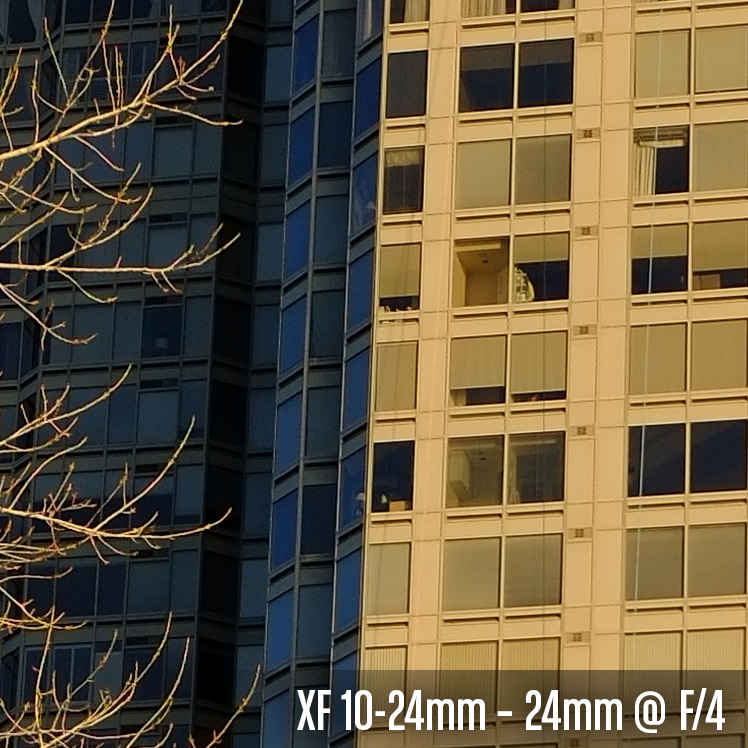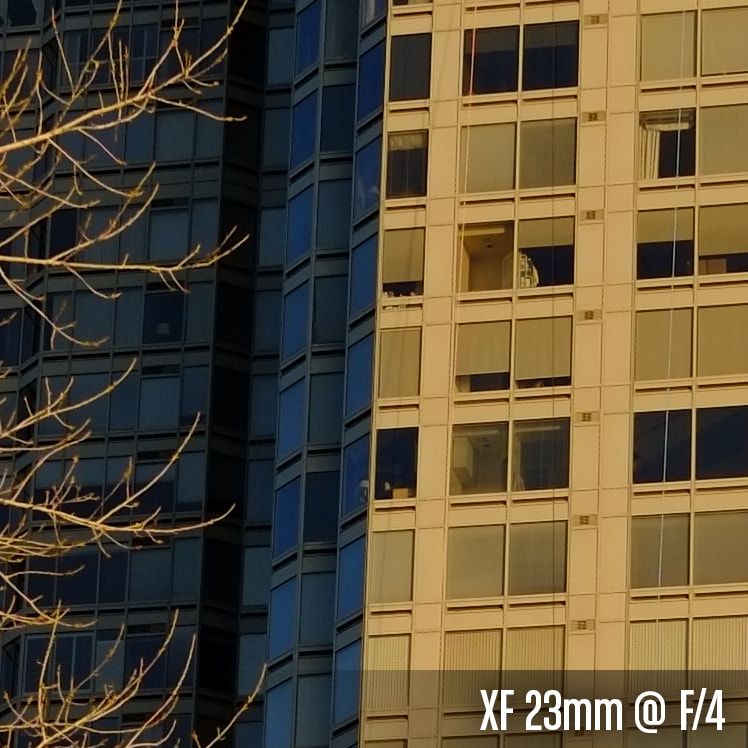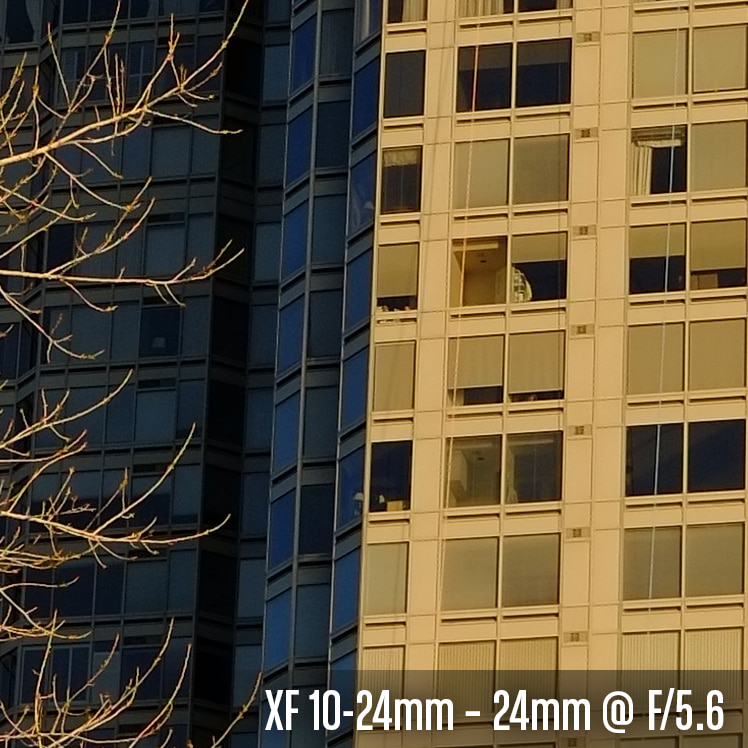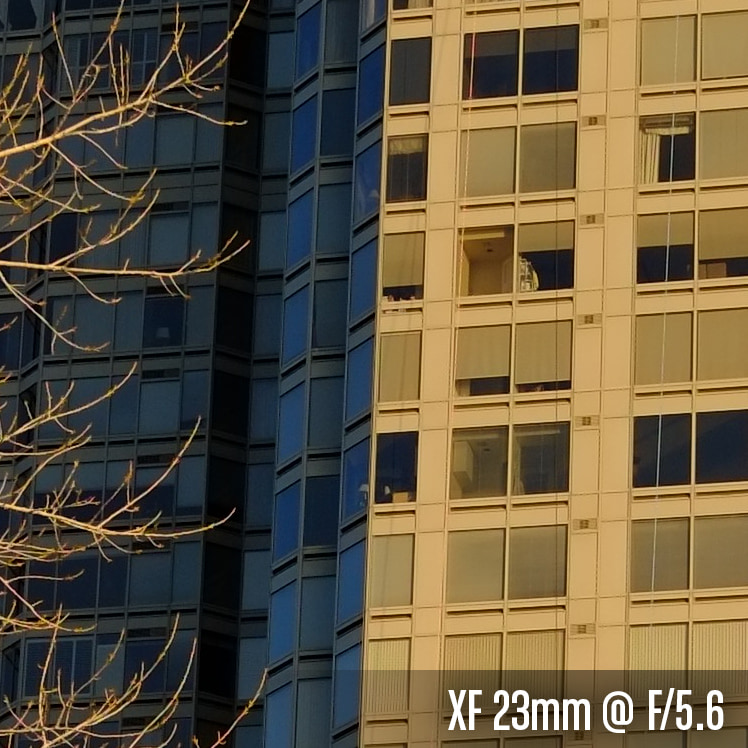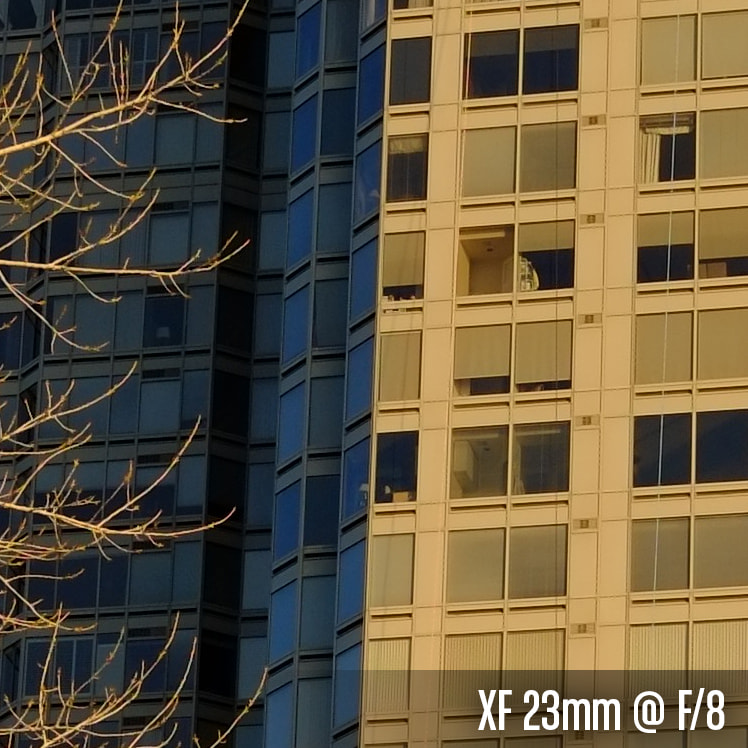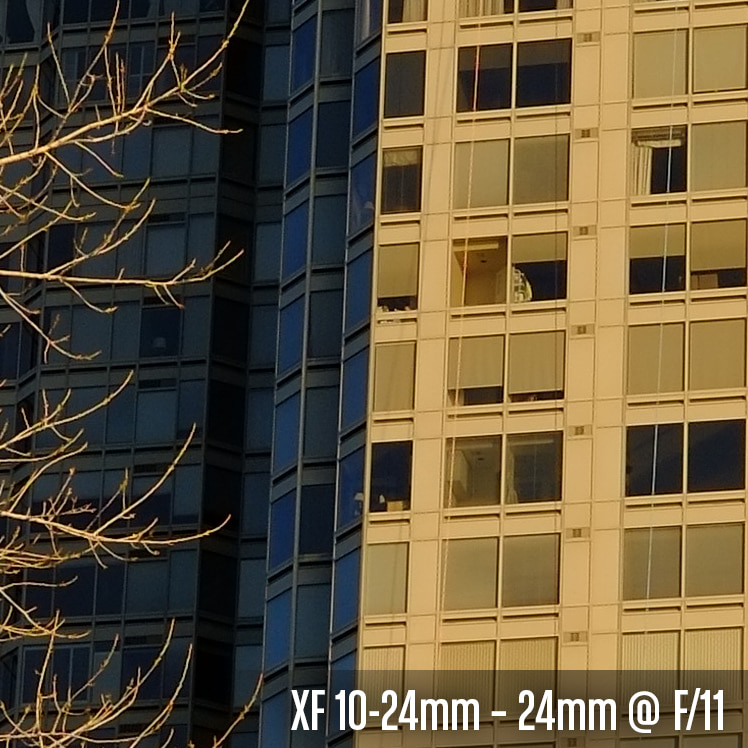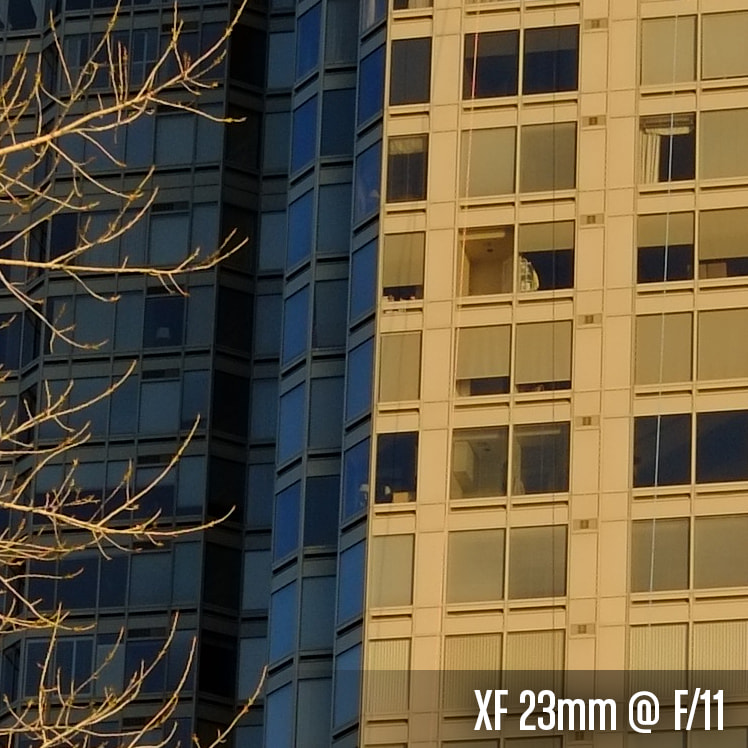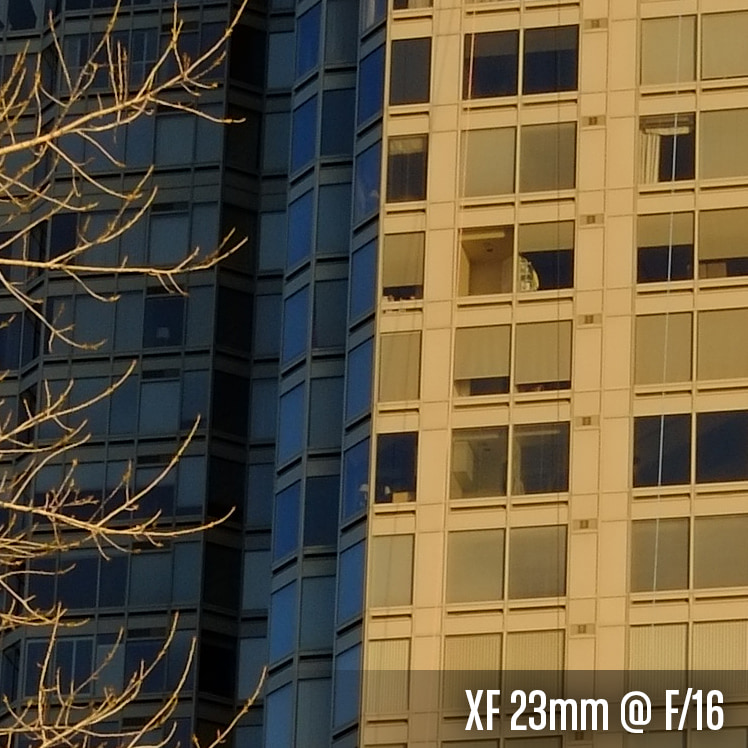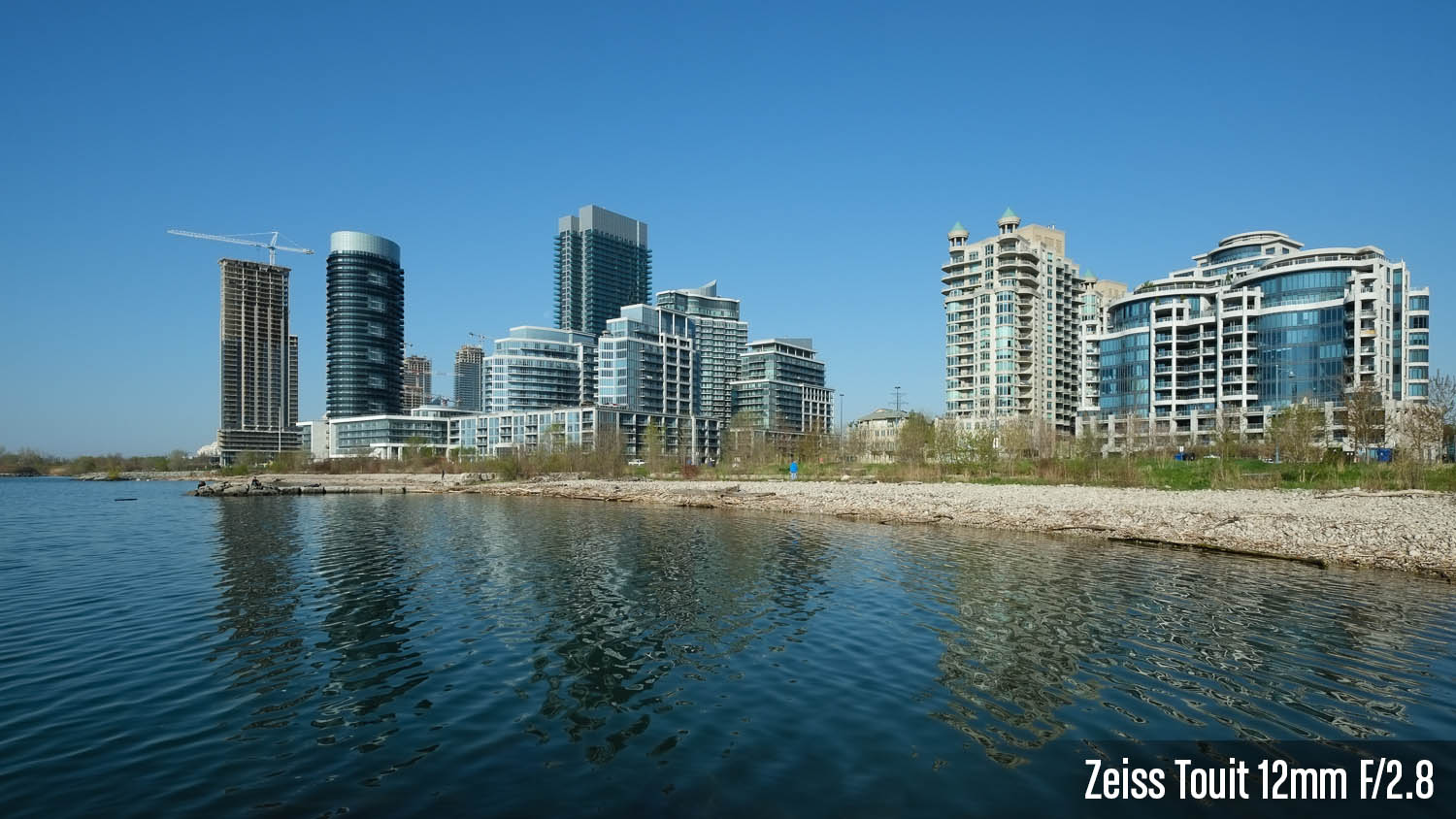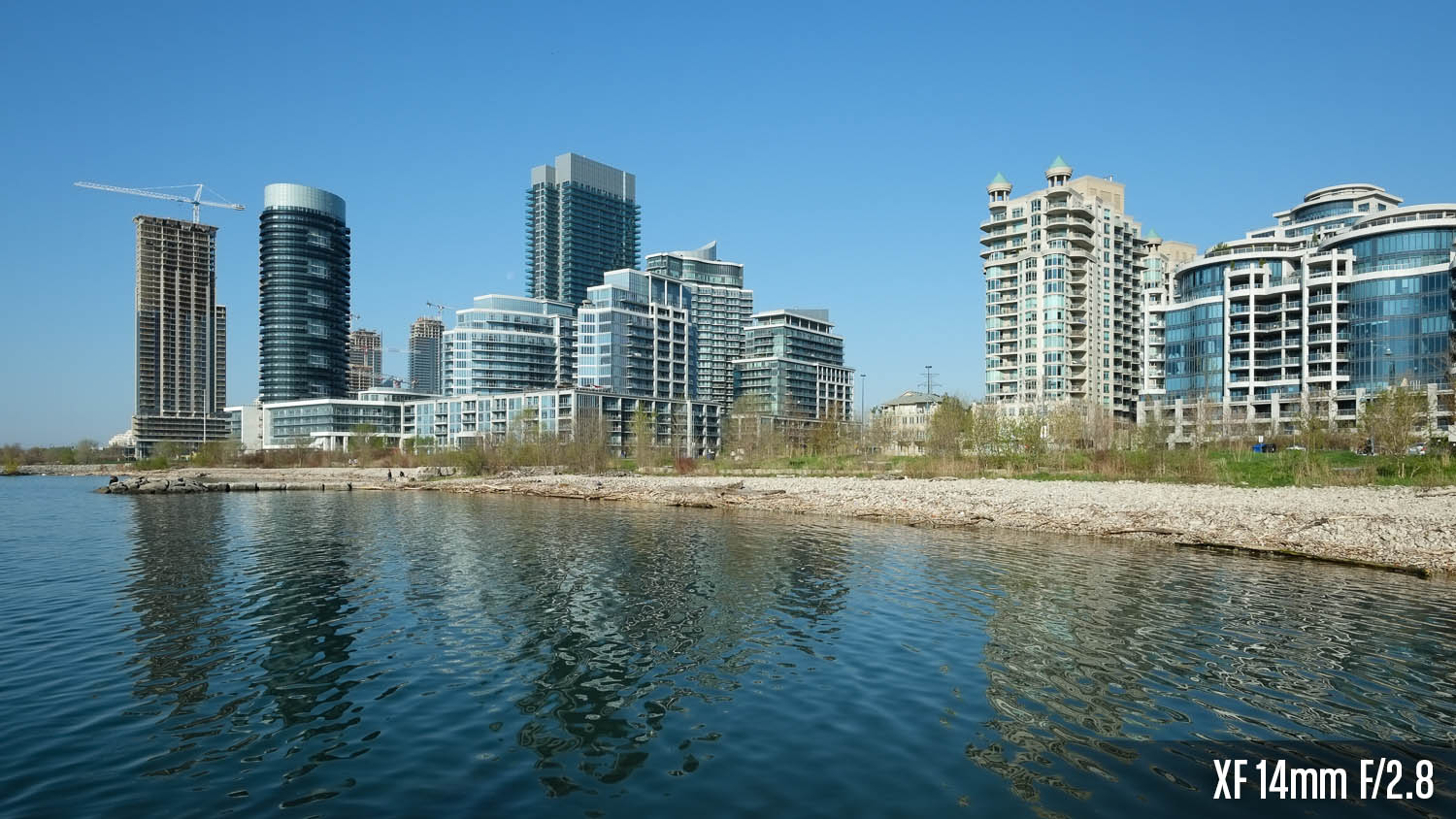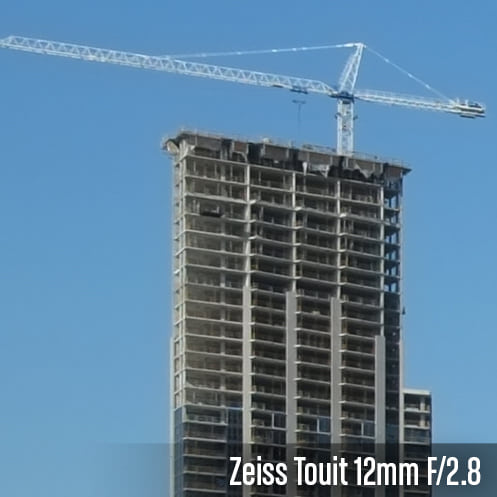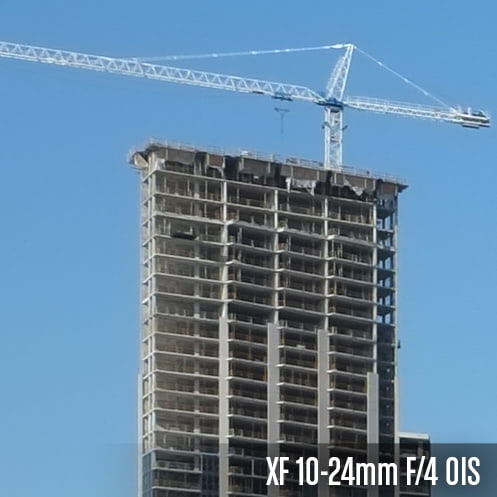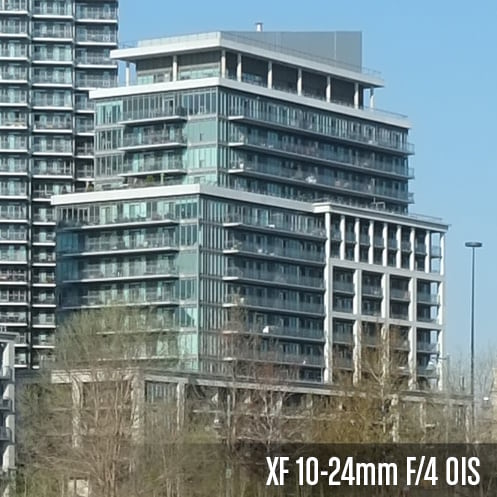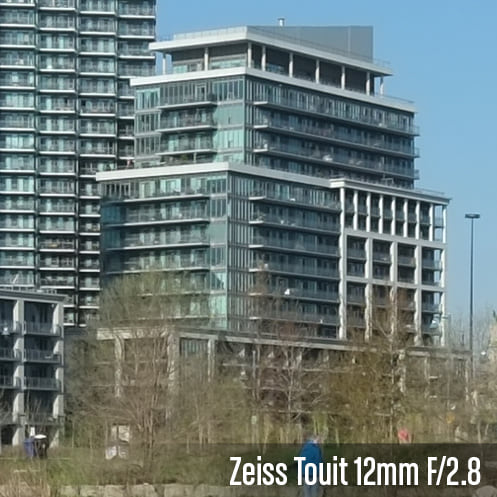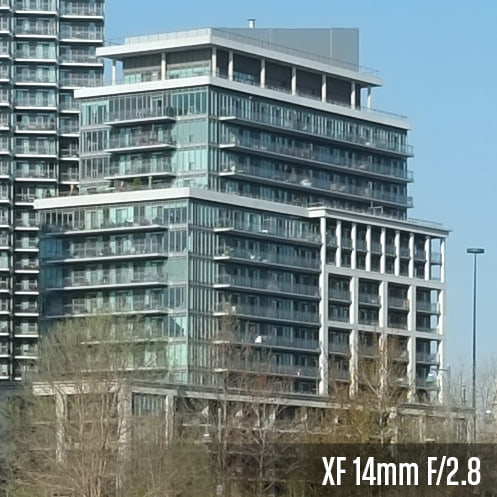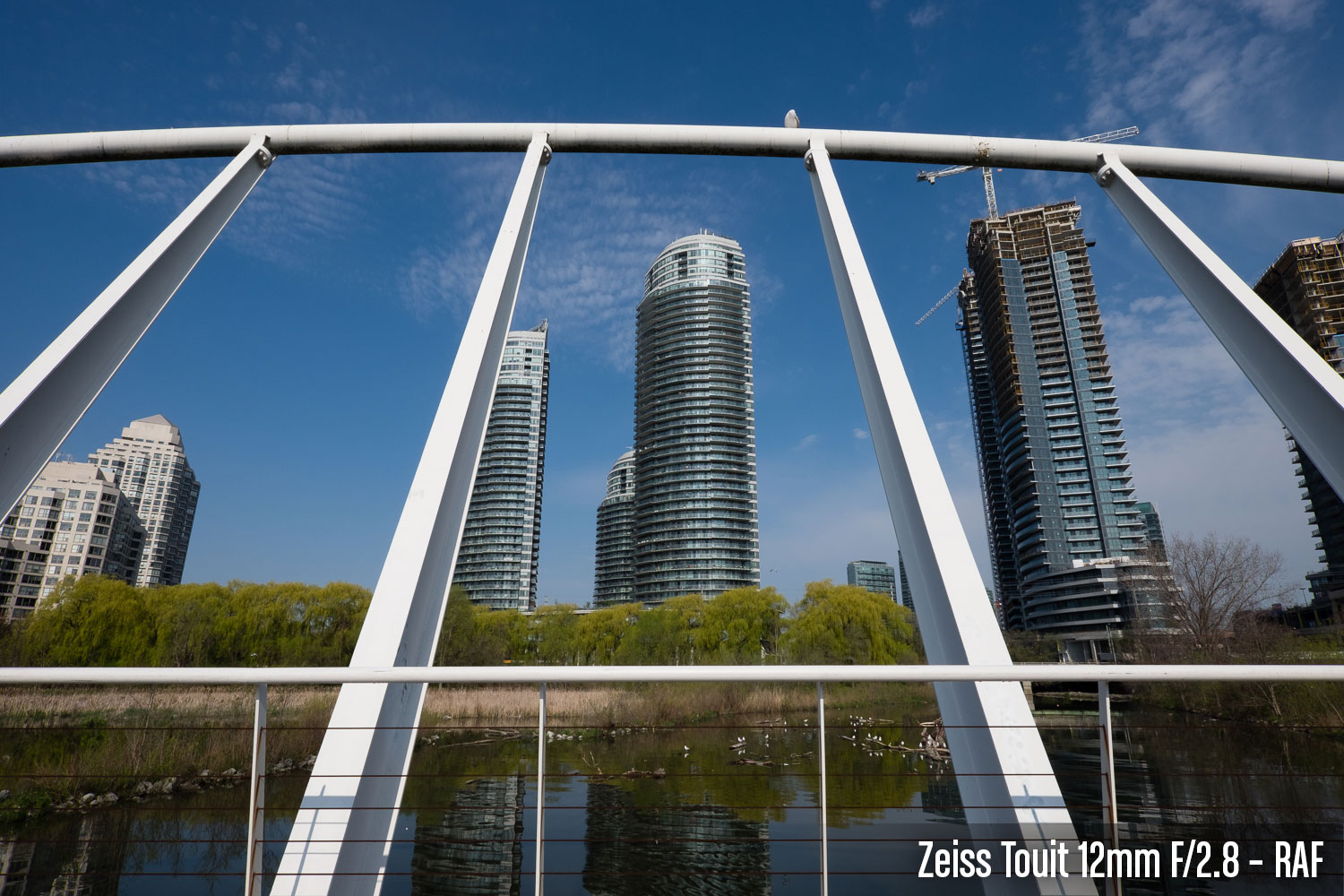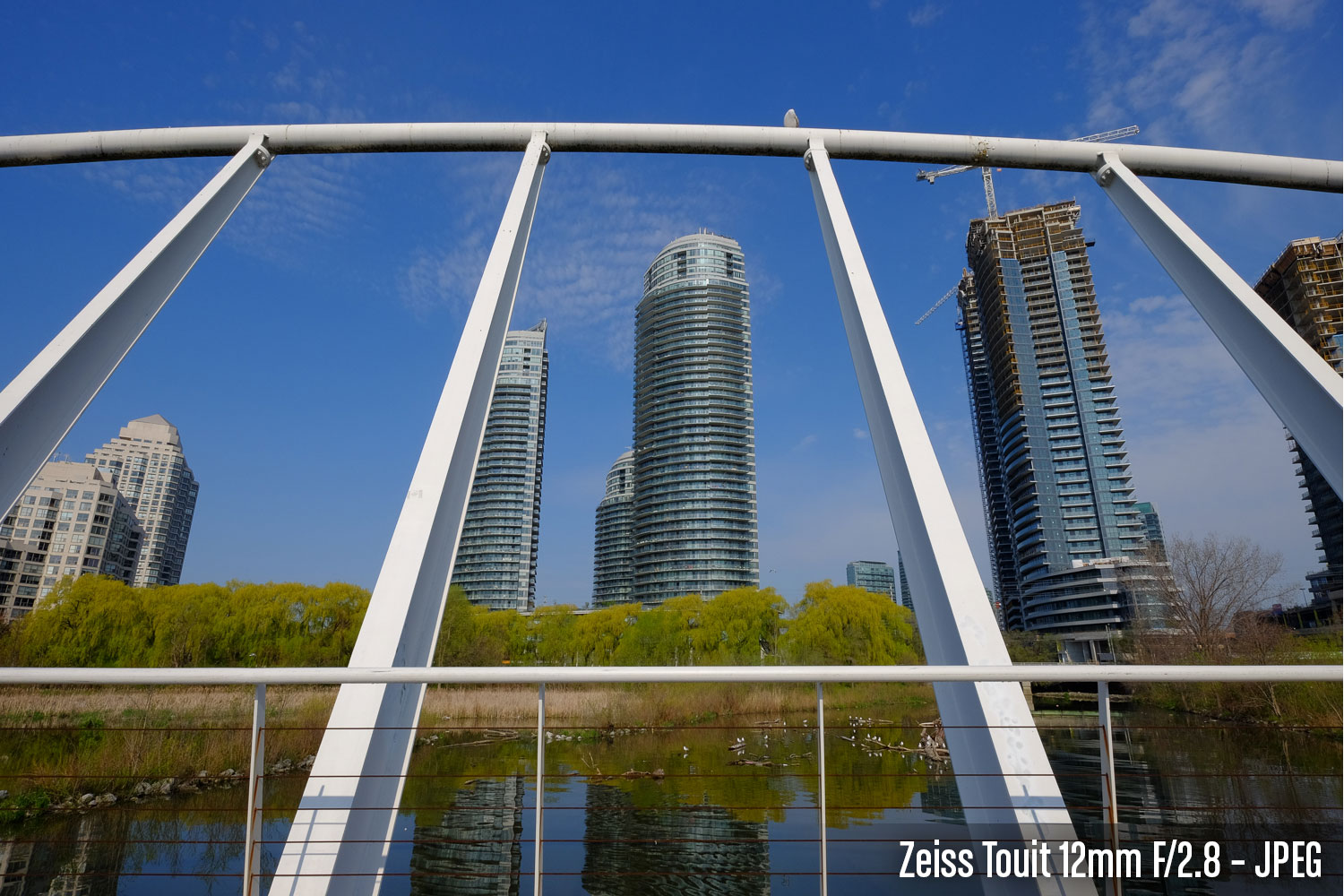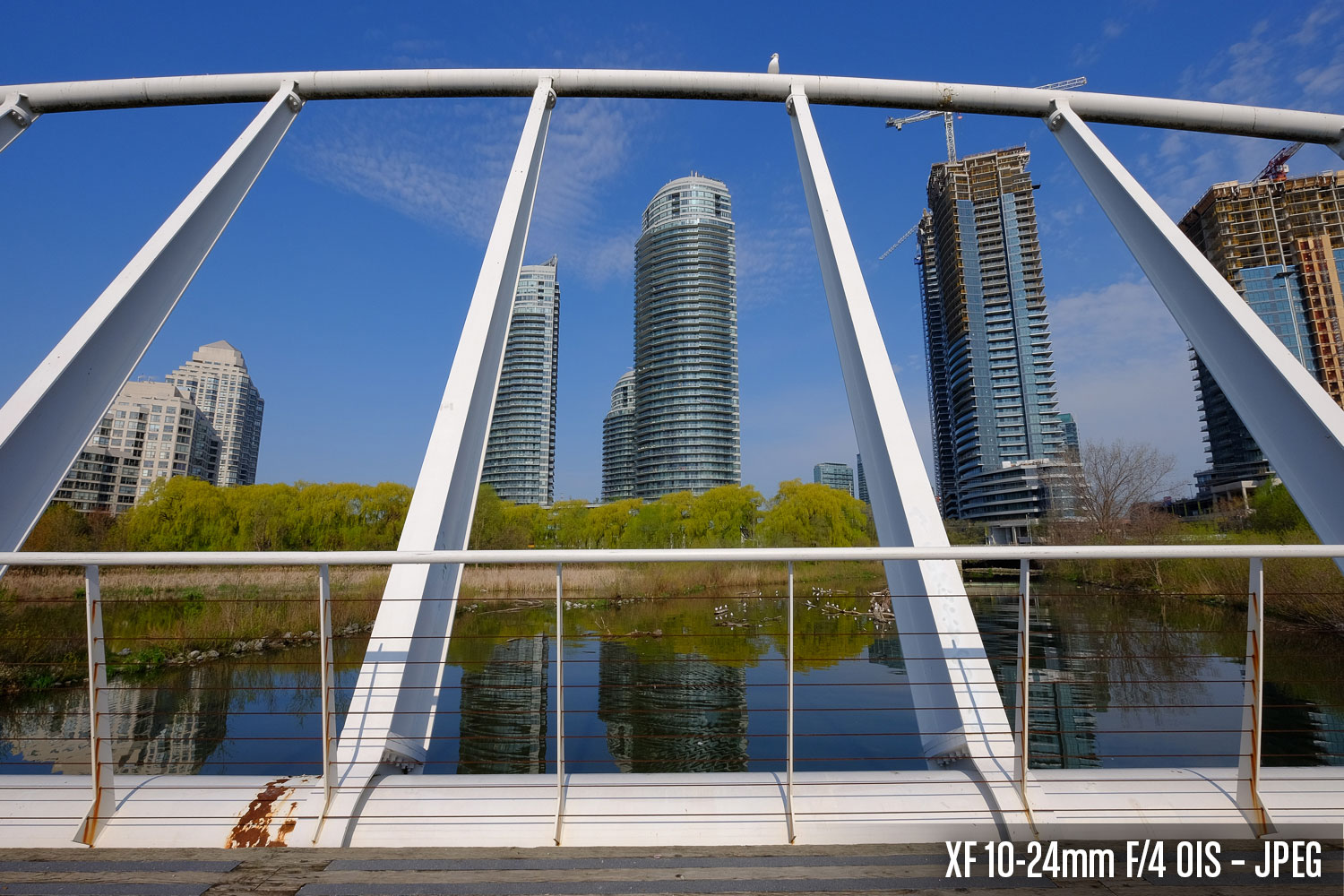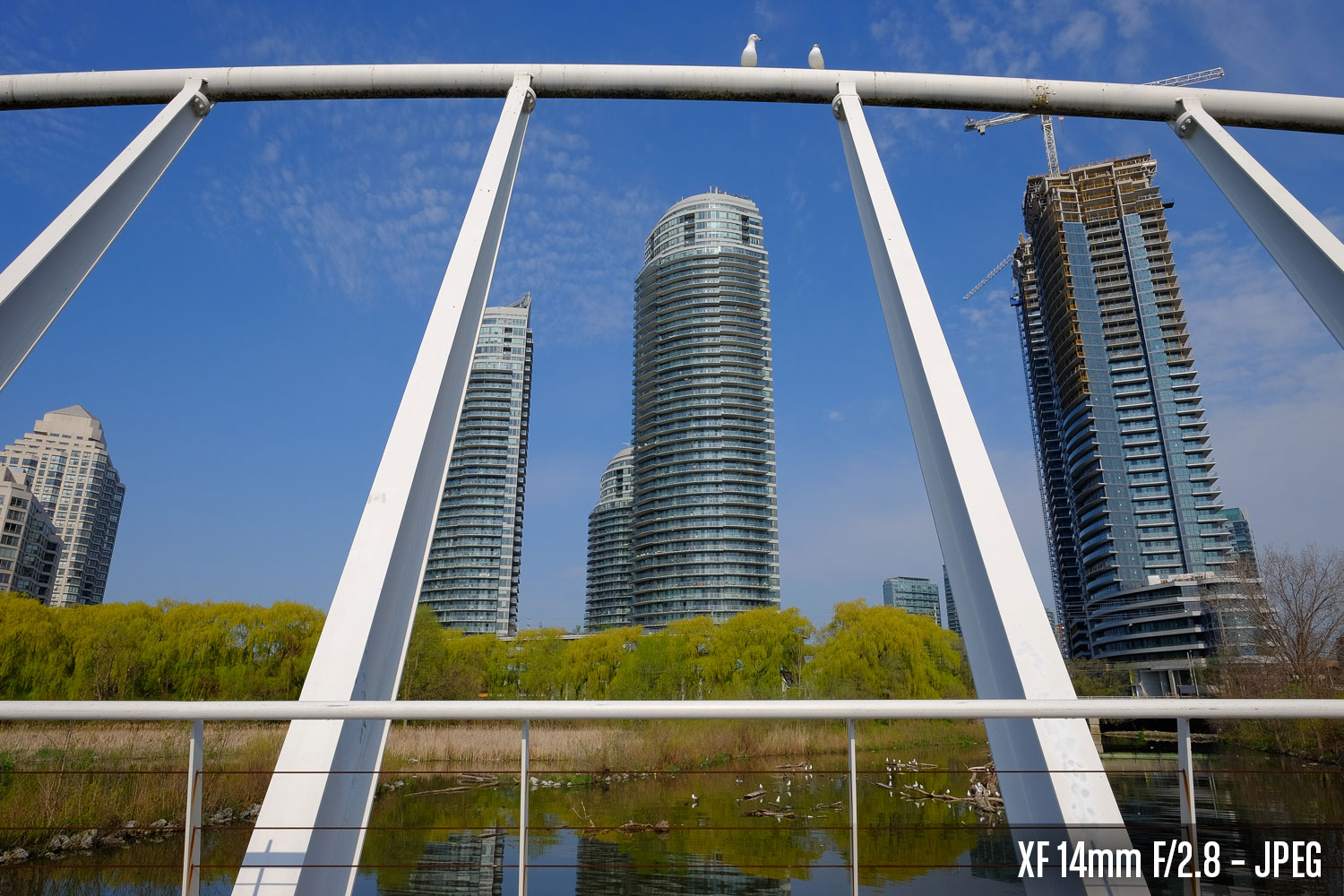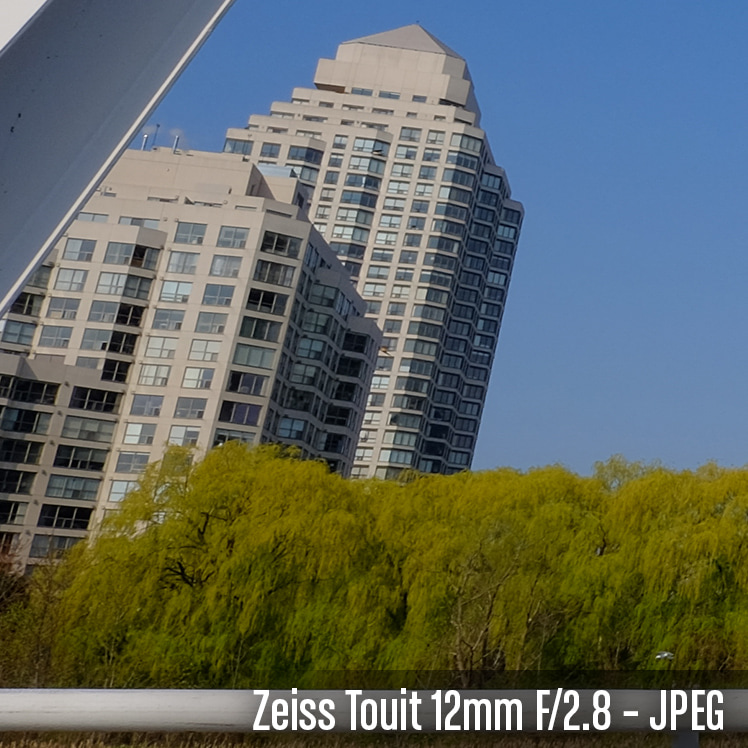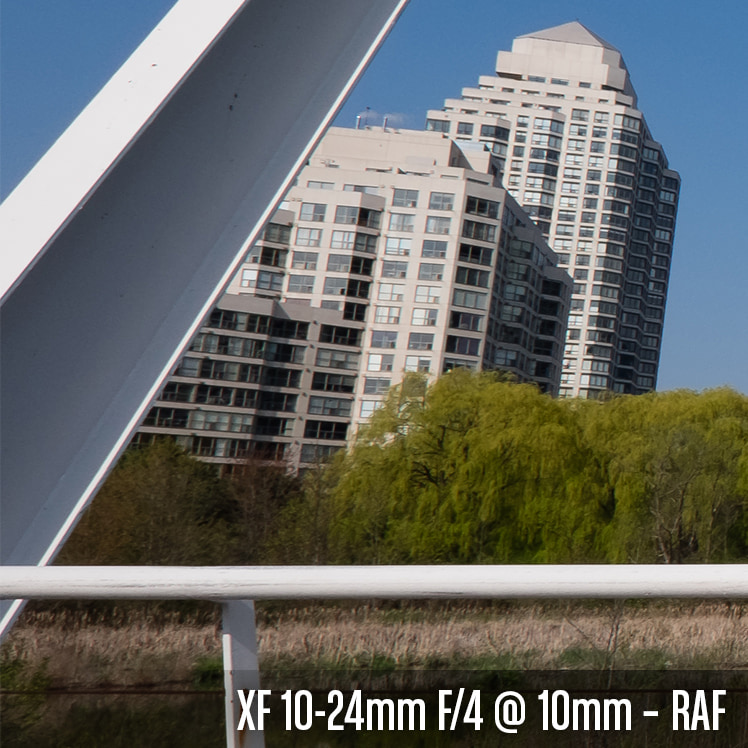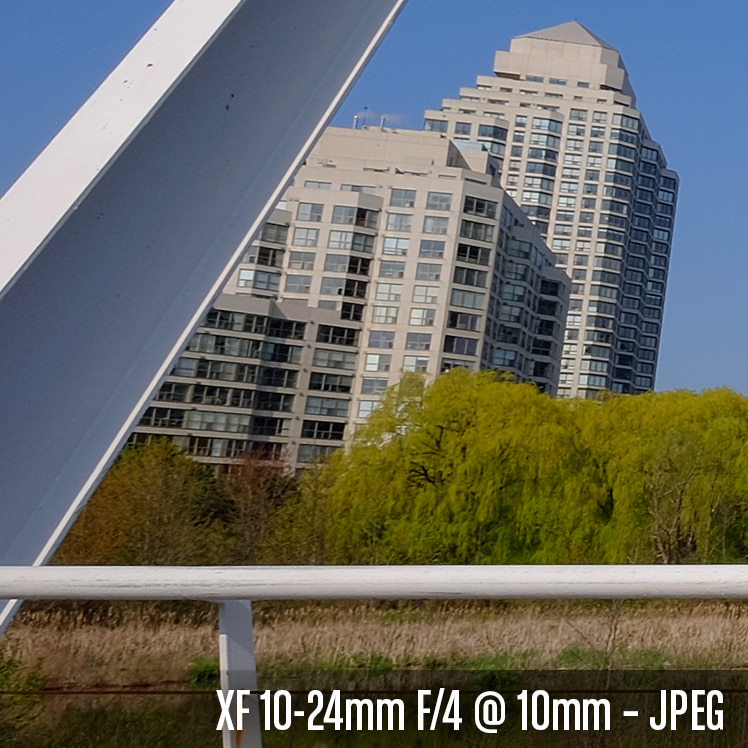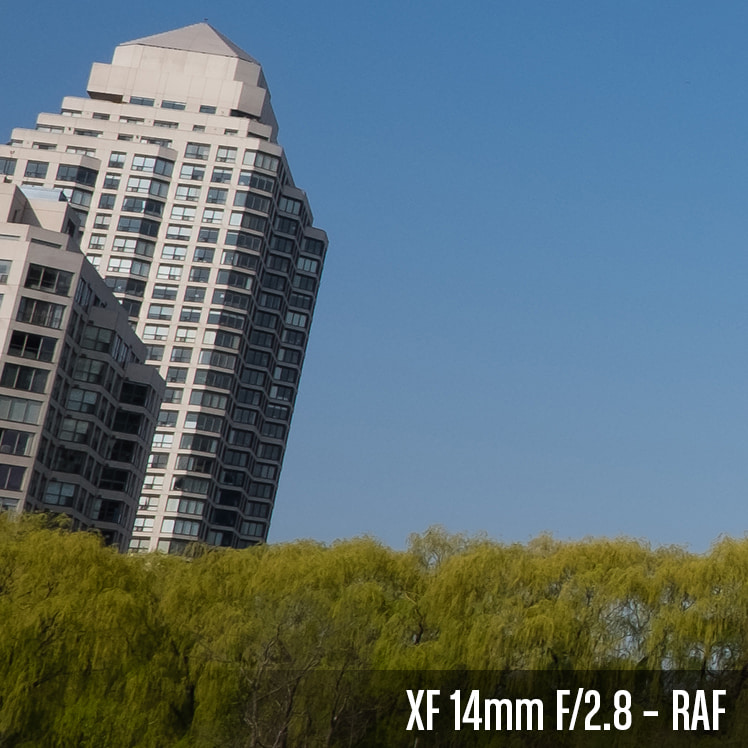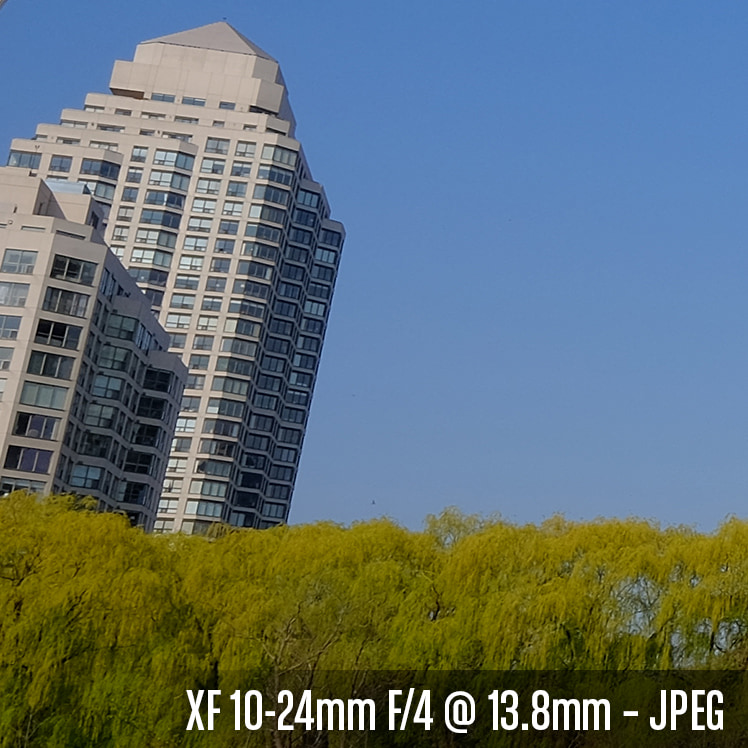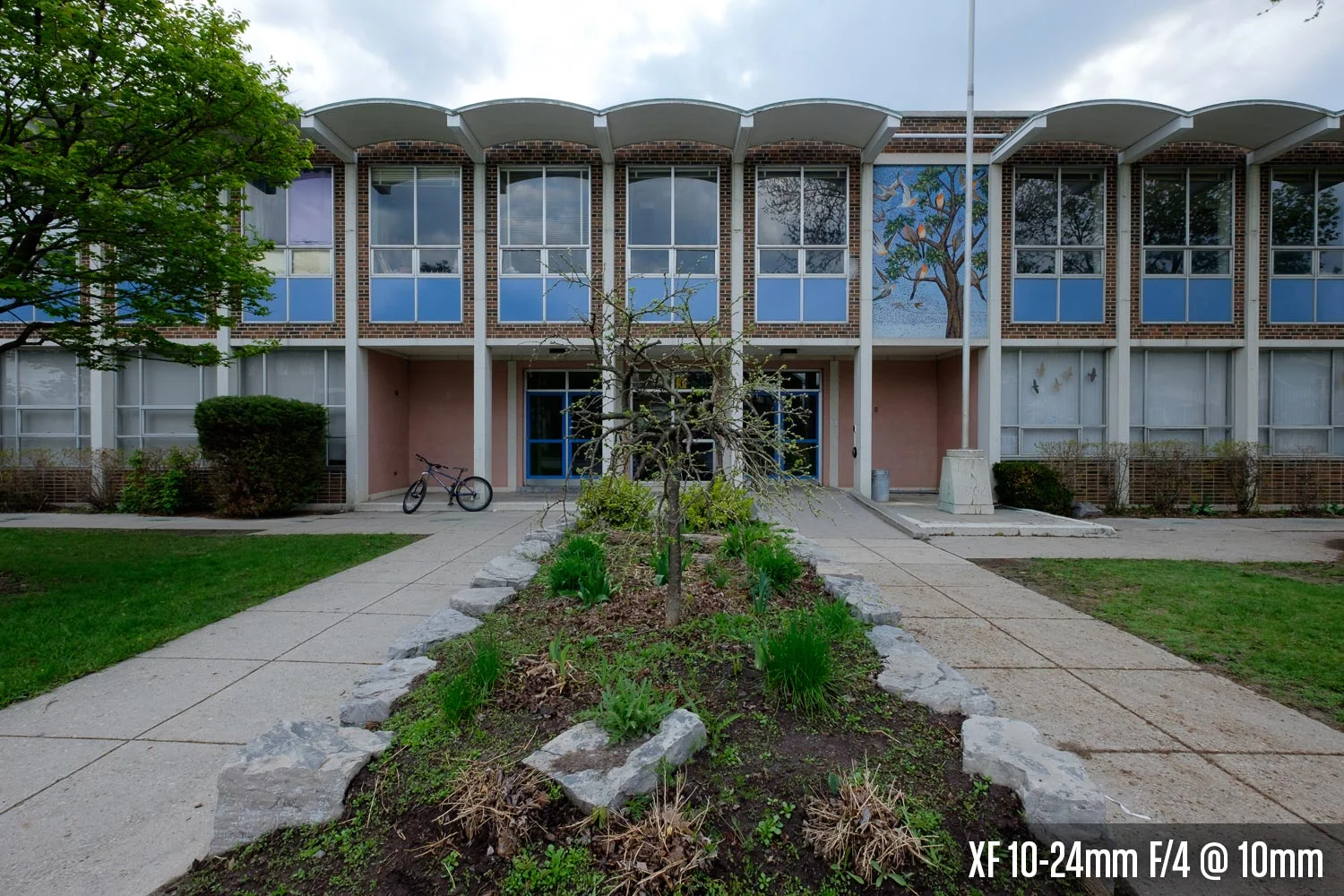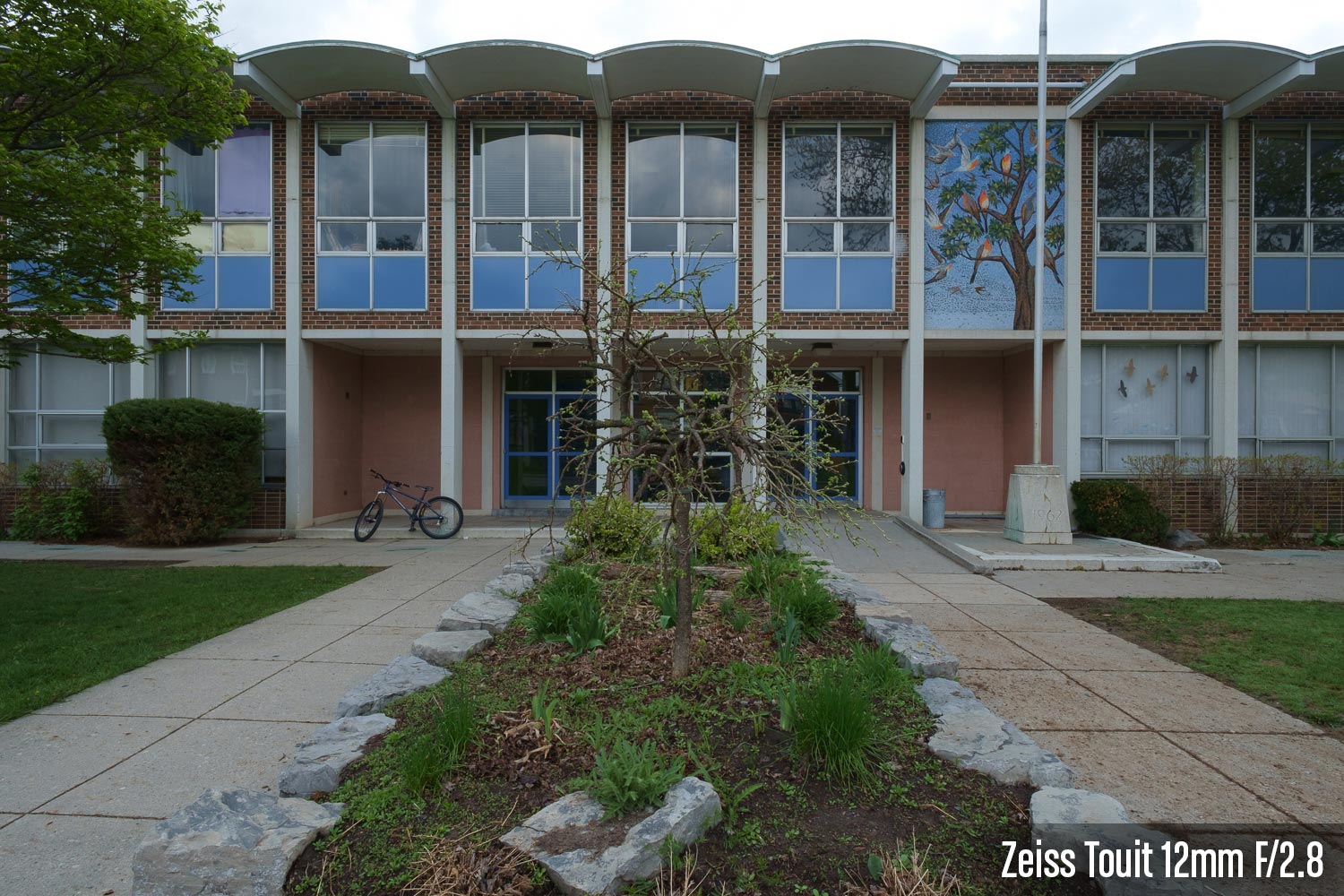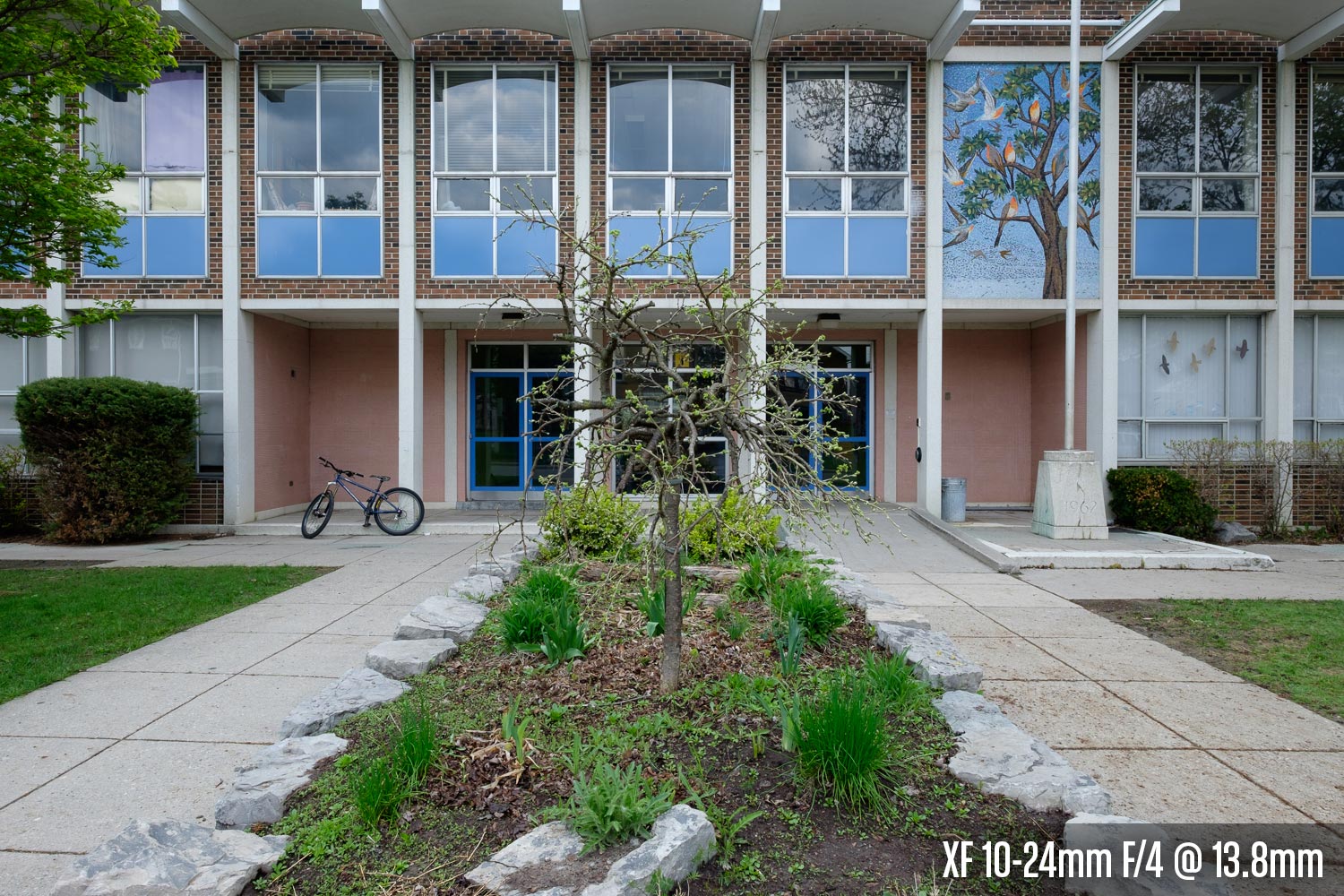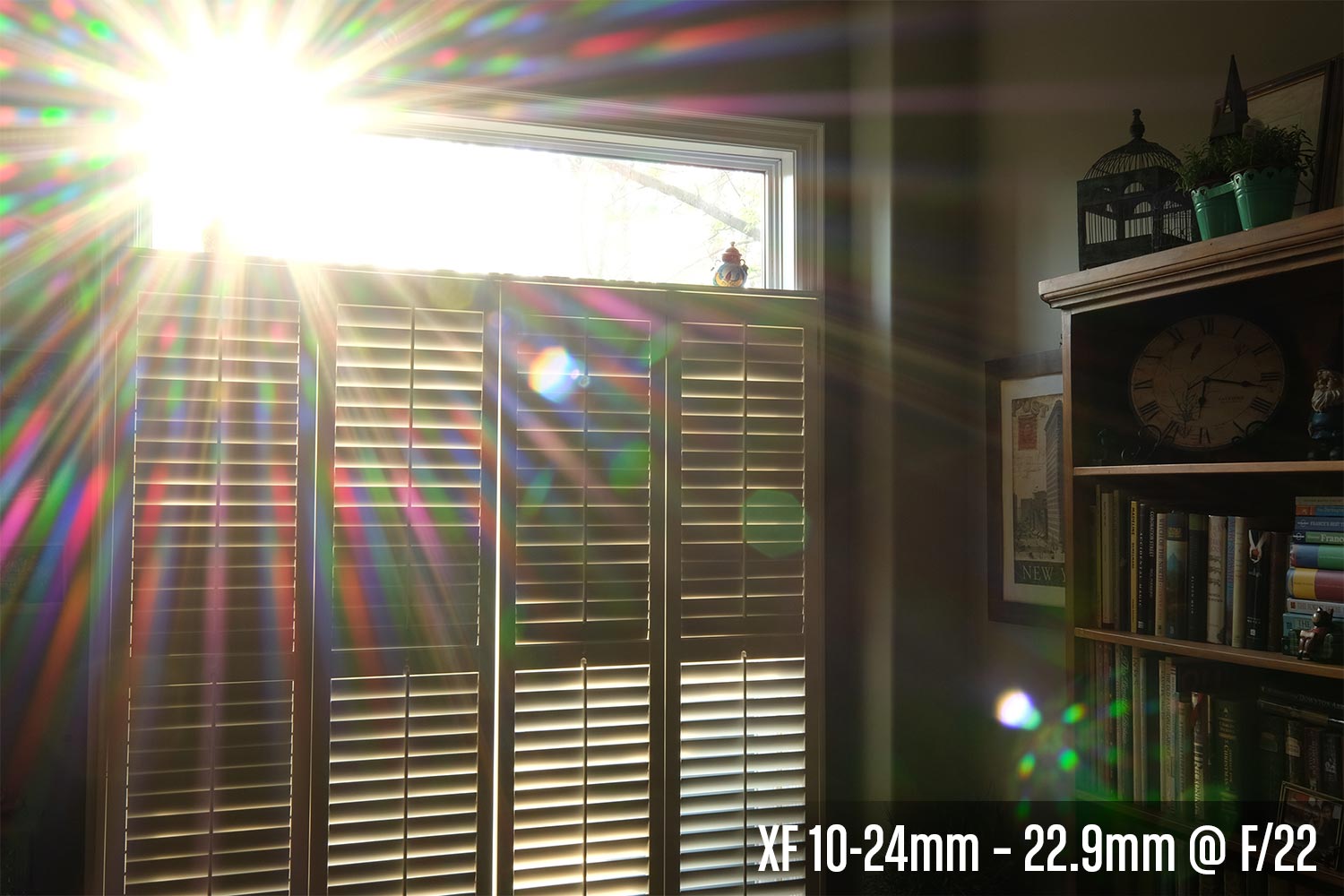Fujifilm XF 10-24mm F4 OIS vs. XF 14mm F2.8 vs. XF 18mm F2 vs. XF 23mm F1.4, a comparison between Fuji’s ultra-wide to wide angle zoom lens and 3 primes.
July, 2015: Originally published.
March, 2017: Complete revision to text and sample images.
Introduction
After I made the jump from DSLR to mirrorless, I had been waiting for the lens that would fill the void left by my 14-24mm ultra-wide to wide angle zoom. It was on the roadmap, but months away, and Fujifilm didn’t have a prime that that got even close to a 14mm full frame equivalent. 3rd party offerings like Zeiss’s Touit 12mm got us closer, but still not quite to the width I was used to, and its sharpness had been called into question.
Fujifilm’s XF 10-24mm F4 OIS covers a fairly substantial range, from 15mm, all the way to 36mm in 35mm equivalence. That’s 1mm narrower on the wide end than I had on full frame, but a full 12mm more on the long end of the focal range. The question is, can Fuji’s ultra-wide to wide angle zoom produce photos at a standard of quality that truly realizes its convenience?
Testing notes:
I did my best to match focal lengths, but getting the XF 10-24mm F4 OIS at exactly 14, 18, and 23mm was extremely difficult, if not impossible. I usually ended up with the EXIF data saying I was at 13.8, 18.2, and 22.9mm respectively, and no amount of minor tweaking netted me more exact readings. I tweeted to The Fuji Guys that showing the exact focal length in the viewfinder when using zoom lenses would be handy. They acknowledged, but we’ll just have to wait and see what Japan does. As it turns out, the EXIF data wasn’t the most reliable gauge. For instance, the XF 10-24mm F4 OIS at 24mm is closer in field of view to the XF 23mm F1.4 than it was when set to 22.9mm.
Also note that my tripod did not move between images. Only my lens changed or, in some cases, the whole camera was swapped out, but realigned to the markings on my support system.
XF 16mm F1.4 WR
This comparison was done before the XF 16mm F1.4 WR was announced. For a detailed comparison of how it stacks up against the two wide angle primes in this piece, checkout my Wide Angle Primes article, and my review of the XF 16mm F1.4.
Specifications
| XF 14mm F2.8 | XF 18mm F2 | XF 23mm F1.4 | XF 10-24mm F4 | |
|---|---|---|---|---|
| Announced | June 27, 2012 | January 9, 2012 | September 5, 2013 | December, 18 2013 |
| Released | January, 2013 | February, 2012 | October, 2013 | March, 2014 |
| Price (MSRP) |
$899 | $599 | $899 | $999 |
| Lens Construction | 10 elements, 7 groups 2 aspherical, 3 extra low dispersion elements |
8 elements, 7 groups 2 aspherical elements |
11 elements, 8 groups 1 aspherical element |
14 elements, 10 groups 4 aspherical, 3 extra low dispersion elements |
| 35mm Equivalent | 21mm | 27mm | 35mm | 15 - 36mm |
| Angle of View | 89˚ | 76.5˚ | 63.4˚ | 110° - 61.2° |
| Aperture Range | f/2.8 - f/22 | f/2 - f/16 | f/1.4 - f/16 | f/4 - f/22 |
| Focus Range | Approx. 18cm - Infinity | Approx. 18cm - Infinity | 0.6m (28cm Macro) - Infinity | 0.5m (24cm Macro) - Infinity |
| Maximum Magnification | 0.12x | 0.14x | 0.1x | 0.16x |
| External Dimensions | 65mm diameter x 58.4mm long | 64.5mm diameter x 40.6mm long | 72mm diameter x 63mm long | 78mm diameter x 87mm long |
| Weight (Measured) | 234.5g 272g with caps and hood |
118g 149g with caps and hood 139g without hood |
296g 344g with caps and hood |
404g 455g with caps and hood |
| Filter Size | 58mm | 52mm | 62mm | 72mm |
What’s in the box
We’ve gone form elegant magnetic enclosure with the XF 18mm F2, to a blacked out version of the fast-food drink tray with the XF 14mm F2.8 all the way to the bottom of the unboxing barrel with the XF 10-24mm F4 OIS. The pouch is still too large and will stay in the box for me, but at least Fujifilm are still including the hood which is what really matters.
Handling
This is where things start to get interesting. Outside of size and weight, these lenses, and Fujifilm lenses in general handle quite similarly. The primes handle the way all the primes do, and the XF 10-24mm F4 OIS handles almost exactly the way the 18-55mm kit zoom does with the only real difference being the rubber zoom ring. While I don’t mind the rubber zoom ring, I prefer the metal version on the XF 18-55mm F2.8-4. Ironically, Fuji’s engineers cite improved grip a the key reason for the rubber zoom ring. To my hand, the zoom ring on the kit lens is easier to turn, but one thing the different material of the XF 10-24mm F4 OIS offers is immediate tactile feedback that you’ve grasped the right part of the lens. It’s a little bit easier to think you’re zooming when you’re actually spinning the focus ring on XF 18-55mm F2.8-4.
Speaking of rubber rings, Zeiss features a very different look and feel for their lenses. I’m not crazy about look, for whatever that’s worth. The lenses don’t fit with the Fuji system.
Hoods
The scalloped hood that ships with the XF 10-24mm F4 OIS is quite large and splays out pretty wide. It’s nowhere near as obnoxious as the hood that comes with the XF 23mm F1.4. It reverses well too. My favourite Fuji X-Mount hoods are still the XF 35mm F/1.4 and XF 18mm F2. They just look cool to me, fiddly cap and all. The XF 23mm F1.4 now has a metal LH-XF23 accessory hood.→ I really like similar add-on hood for the XF 16mm F1.4 WR, but on the copy I got the the XF 23mm F1.4, the cap does not stay on solidly.
The Zeiss has a plastic bayonet-style hood as well. It doesn’t reverse as well as the others, and the lens becomes quite large with it on. With that said, the Zeiss looks much more incomplete with the hood attached. It actually appears as though part of the lens contraction has been removed. Again, looks shouldn’t matter a great deal, but they do matter.
Lens Caps
As I’ve done with most of Fuji’s earlier lenses, I purchased a Nikon cap→ to replace the cap that comes in the box. They just work better for me. Thankfully the caps shipping with Fuji’s more recent lenses are excellent.
Aperture Rings
The aperture ring on the two copies of the XF 10-24mm F4 OIS I’ve handled feels exactly the same as the kit zoom. They click great and there is no play in them. One thing I’m a little confused by is why the XF 10-24mm F4 OIS has an unmarked aperture ring. The XF 18-55mm F2.8-4 I understand as it’s a variable aperture lens, but the 10-24mm is F4 throughout its zoom range so it seems Fujifilm could have saved themselves the aperture control switch altogether.
The rings on the primes are another matter where there has been a ton of sample variation. It has improved considerably with the XF 23mm F1.4—the most recent release of the primes in this comparison—but you’ll still want to check the rings carefully while you’re within your return policy or before you leave the store.
Focus Rings
Again the XF 10-24mm F4 OIS features a similar design as the XF 18-55mm F2.8-4 where the focus ring is separated by an elegant chrome ring. With the XF 10-24mm F4 OIS, the ring size increases, making it even easier to know what part of the lens your hand is on without taking your eye from the viewfinder. I’d have loved engraved depth of field markings like we have on the XF 14mm F2.8 and XF 23mm F1.4.
Size & Weight
None of these lenses can touch the XF 18mm F2. This is where the original wide angle prime really shines. It’s ridiculously small and light. It can be tossed in your bag (or your jacket pocket) without you even noticing it. The XF 14mm F2.8 is on the light side too and isn’t terribly large. The XF 23mm F1.4 is heavier, but not much larger. The XF 10-24mm F4 OIS dwarfs all of them. You won’t be terribly discrete with this lens mounted on your camera.
The X-T and X-H are my favourite body-styles to use the XF 10-24mm F4 OIS on, as it balances very well on either. Without any extra grip and a simple wrist strap, I could let the camera dangle from my finger tips on the X-T1, however, the slight change in the grip and compound of rubber mean I can’t on the X-T2.
All of the primes are serviceable on the X-E bodies. The XF 23mm F1.4 gets a little front-heavy and you can probably forget about one-handed use for long, but otherwise it’s ok.
A Brief Zeiss Touit 12mm f/2.8 Handling Interlude
Midway through my testing, I received a demo copy of the Zeiss Touit 12mm f/2.8→. I was mostly interested in how it compared the the XF 10-24mm F4 OIS and XF 14mm F2.8. Zeiss has a very different look and feel for their lenses. I’m not crazy about the look, for whatever that’s worth. It just doesn’t fit with the X Series system.
The rubberized aperture ring on the copy of the Zeiss I had felt a little bit hollow somehow. It was a dealer sample, so it’s been around the block and then some, but still, it was a little worrisome that after a lot of use, the ring felt the way it did. I should note that I sampled a few copies of the Zeiss 32mm f/1.8→ and they all felt much better. The Zeiss has a plastic bayonet-style hood. It doesn’t reverse as well as the others, and the lens becomes quite large with it on. With that said, the Zeiss looks much more incomplete with the hood attached. It actually appears as though part of the lens construction has been removed. Finally, the Zeiss cap is terrible. Probably the worst lens cap I’ve used.
Weight in grams
Things get really interesting when we add a full frame ultra-wide zoom into the mix.
For giggles, here’s how all the Fujifilm lenses compare to just one full frame zoom lens.
Yep, you can carry all 4 lenses for about 50g more weight.
What about the X-Pro?
The XF 10-24mm F4 OIS balances well on X-Pro cameras, but the problem is its key advantage—the OVF—is of much less value with lenses this wide. A full 50% of the XF 10-24mm F4’s zoom range will leave some of your photograph out of the frame. It isn’t until 18mm that you can actually see all of your photo, but even then, the XF 10-24mm F4 OIS is so large, it obstructs too much of the OVF for it to be much good. This leaves you with the EVF, which, on the second generation of X-Pro camera is fine, but if you still happen to be rocking the original X-Pro, it’s EVF could leave you wanting.
Below are some images for reference. Rollover for their description. Apologies for the poor quality.
Autofocus Performance
When I originally wrote this article, I wrote:
Your camera body will make a bigger difference in AF performance than your lens choice. Autofocus with each of these lenses is pretty swift. I wouldn’t let autofocus pace determine which of these lenses you choose.
That was true back when the X-T1 was brand new, but now that Fuji’s firmware has been tweaked and optimized, the reverse is true. The XF 14mm F2.8 was once the lens Fuji used as there benchmark for AF speeds. The zoom lens is just as quick, and now, I would definitely say the XF 18mm F2 and XF 23mm F1.4 would be the slower focusing of the bunch.
For those interested, here is the chart I originally used to illustrate the differences. The “failed to focus” on the X-E1 is my favourite part.
Sitting in my basement with a single floor lamp on, I did a test, focusing on a speaker across the room. Here’s the success/failure rate:
| Camera | X-E1 | X100S | X-E2 | X-T1 |
|---|---|---|---|---|
| Success Rate | 0/5 | 4/5 | 3/5 | 5/5 |
| Focus Speed | Failed to focus | Slower | Faster | Fastest |
We sure have come a long way.
Sharpness
I bet a lot of you scrolled down to this bit. To preemptively sum up, if you shoot JPEG, you’ll have no issues with the XF 10-24mm F4 OIS. Fuji’s Lens Modulation Optimizer works some pretty serious magic with it, right out to the corners. If you’re a RAF shooter and looking for maximum acuity over versatility or the widest angle of view, you may want to stock a prime or two in your bag.
Building at Sunrise
First of all, there seems to be a little bit of a bug in either the X-E1 or the XF 10-24mm F4’s firmware. As I was attempting to nail down the 14mm focal length, the camera’s EXIF data was showing <14mm until I reached the point in the photo to the right. What I ended up with is my XF 10-24mm F4 OIS images being at 14.5mm. That 0.5mm makes a difference in the field of view, but I think we’re still ok to make our comparisons.
XF 10-24mm F4 OIS vs. XF 14mm F2.8
The XF 14mm F2.8 is an incredible lens. The detail it resolves is astounding. The XF 10-24mm F4 OIS actually keeps pace with the 14mm in this test, and maybe even exceeds it in the centre of the frame. Across all the apertures I’m seeing equally crisp details in the building and on the bare tree branches in front of it. Keep in mind there was a bit of a breeze that morning so the tree can’t be used as your only guide. Make your way into the corners and the XF 14mm F2.8 holds detail a little better up to f/8. By f/11 things even out in the corners to my eye. Objectionable diffraction starts to set in on both lenses at f/16 and hits the XF 14mm F2.8 a little harder by f/22.
Centre Crop
Left Edge
Bottom Right Corner
Bottom Left Corner
The extreme corner of the XF 10-24mm F4 OIS is quite smeared up to and including f/8. By f/11, the zoom closes the gap considerably.
XF 10-24mm F4 OIS vs. XF 18mm F2
When it comes to the XF 18mm F2, the prime outperforms the zoom at its maximum aperture, but the the tide shifts from f/5.6 and on. By f/8, the XF 10-24mm F4 OIS is much sharper than the XF 18mm F2. This doesn’t really surprise me, but I would have liked a better showing from the prime. This goes to show the lens is not optimized for smaller aperture performance.
Centre Crops
Left Edge
Here was have a demonstration of just how poorly optimized the XF 18mm F2 is for edge to edge sharpness. At f/8, you would hope the edges would be there sharpest, but I had to double check that I hadn’t accidentally used an image with the wrong aperture here.
Bottom Corners
Again, aside from the extremist of corners, the XF 10-24mm F4 OIS is sharper.
XF 10-24mm F4 OIS vs. XF 23mm F1.4
Against the XF 10-24mm F4 OIS, it’s a fairer fight. In the centre of the frame the two lenses are neck and neck, but stray to close to the edge of the frame and the primes shows it’s value very quickly. The corners and edges on the XF 10-24mm F4 OIS become unacceptably soft.
Embarrassingly, I started this series of testing out at the wide end of the primes thinking the whole building would easily still fit within the frame by the time I got to 23mm. Goes to show just how much of a range the XF 10-24mm F4 OIS covers. And curiously, with the zoom racked out to 24mm, it looks to be just barely closer than the 23mm while having the zoom set to 22.9mm appears noticeably wider.
Centre Crops
Top Right
Poorly framing this shot worked out in the end as it shows the smearing that occurs on the XF 10-24mm F4 OIS towards the edges.
Bottom Corners
The prime shows what it’s made of compared the zoom at its maximum reach.
10mm
At 10mm the XF 10-24mm F4 OIS simply has no competition. The images below show how much wider the 10-24mm can go compared to Fuji’s next widest offering, the XF 14mm F2.8. In this test, maximum sharpness is at f/8 with diffraction barely creeping in at f/11. I would want to shoot this lens at f/8 as much as possible and thankfully, there’s heaps of depth of field at 10mm.
Also note the cameo by Yours truly in the bottom left corner. When shooting this wide, things like shadows and splayed tripod legs have a habit of creeping into compositions unexpectedly.
Condos
This is the point during my testing where I got my hands on the Zeiss Touit 12mm f/2.8. This first thing we notice is just how much wider 12mm is compared to 14mm. Once you apply the crop factor, the difference goes up to a hair over 3mm.
XF 10-24mm F4 OIS vs. Zeiss Touit 12mm F/2.8 vs. XF 14mm F2.8
Unfortunately, the sharpness isn’t quite there with my copy of the Zeiss. It’s softer than both the XF 10-24mm F4 OIS and XF 14mm F2.8 across the entire aperture range.
Getting back to the Fuji comparison, to my eye the XF 14mm F2.8 is holding detail ever so slightly better than the XF 10-24mm F4 OIS in the centre of the frame, and it’s even sharper at the edges by comparison. These images were captured with Fuji’s Lens Modulation Optimizer turned off, and both lenses seem to top out at f/8—the aperture used for this comparison—but I wouldn’t think twice about using either at f/11. Diffraction becomes visible by f/16, and both lenses are unacceptably soft by f/22 for detailed landscape work when shooting RAW.
Bridge
In this comparison, I captured both RAF and JPEG as usual, but I found this one particularly useful as it demonstrated how much (or how little) correction is done in camera, and how much wider 10mm is compared to 12mm.
XF 10-24mm F4 OIS vs Zeiss Touit 12mm F/2.8
At the risk of sounding like a broken record, again the Zeiss Touit 12mm F/2.8 appears to be softer, although the difference is a fair bit less pronounced in the RAF files, particularly out towards the edges of the XF 10-24mm F4 OIS. Also of note is that the zoom exhibits some mild vignetting, even on these images which were all shot at f/11.
Zeiss Touit 12mm F/2.8 vs. XF 14mm F2.8
Comparing the Zeiss Touit 12mm F/2.8 to the XF 14mm F2.8 again, and the difference in angle of view is very pronounced. I have to admit that this is quite a bit more significant than I had anticipated, but it hasn’t changed what my preference is overall between the two. JPEGs from the XF 14mm F2.8 are far sharper than those from the Zeiss, but moving to the RAF files, the difference is drastically reduced; so drastically in fact, it makes me wonder if Zeiss need to release a firmware update for this lens. One would think a dealer sample provided by Zeiss would be fully up to date.
XF 10-24mm F4 OIS vs. XF 14mm F2.8
These images are hardly distinguishable in JPEG form. If I had to pick, I’d give the nod to the prime, but really, if you are a JPEG shooter, you won’t be missing much from the zoom. When it comes to RAFs, the XF 14mm F2.8 quality shows again at the edges and in the corners. The difference isn’t huge though.
Crops
In the following crops, the RAF is on the left, JPEG on the right, and I’ve shown the XF 10-24mm F4 OIS at max width compared to the Zeiss Touit 12mm F/2.8 as well as at 14mm compared to the XF 14mm F2.8.
Bokeh!
I won’t go nuts with bokeh comparisons between these lenses. Realistically, if you’re looking for background separation, you want either the XF 23mm F1.4 or XF 18mm F2. The XF 10-24mm F4 OIS can render some nice out of focus backgrounds when shot at f/4 and up close, but shallow depth of field isn’t what it’s built for though.
Potted Flower
XF 10-24mm F4 OIS vs. XF 23mm F1.4
It should come as no surprise that the XF 23mm F1.4 renders backgrounds with loads more blur at f/1.4 than anything the zoom can achieve. What’s interesting though is the quality of the bokeh from the XF 10-24mm F4 OIS at F/4. I’d never be able to tell which of these images apart from their bokeh. Click to enlarge.
XF 10-24mm F4 OIS vs. XF 18mm F2
Once again, no surprise that an f/2 lens can separate a subject from the background better than an f/4. At f/4 though, the bokeh balls from the XF 18mm F2 are much nicer. They’re very small, but I can make out a bit of onioning on the zoom. Click to enlarge.
XF 10-24mm F4 OIS vs. XF 14mm F2.8
The XF 14mm F2.8 only has a stop on the zoom, but it does make a noteworthy difference in background blur. By f/4 I can barely tell these images apart aside from the cooler rendering of the XF 10-24mm F4 OIS, but I’d say the XF 14mm F2.8 has the edge.
Realistically, these are not the lenses and focal lengths you want to use to make your background disappear. My neighbour, Norm, there is clearly visible, tending to his garden. Click to enlarge.
Zeiss Touit 12mm F/2.8
The extra 2mm compared to the XF 14mm F2.8 makes a bit of a difference in background separation, but really if you just get a bit closer, you’ll be able to achieve very similar results.
By 10mm, so much is in focus it’s hardly worth making a comparison. The nice thing is you can shoot wide open with the zoom and still get lots of depth of field provided you focus far enough away. Couple that with the OIS and you can get crazy depth of field handheld in awfully low light. Click to enlarge.
Park Garden
XF 10-24mm F4 OIS vs. XF 18mm F2
A quick comparison with the XF 18mm F2. If you look closely, the moon that’s visible at f/4 on both lenses completely disappears at f/2.
My tripod did not move during these tests, and in this case, I changed lenses rather than swap out the camera. The EXIF data shows the XF 10-24mm F4 OIS was at 18.2mm, but it certainly appears as though it is more than 0.2mm closer than the XF 18mm F2. Even the background at f/4 gets a little extra bit of blur compared to the XF 18mm F2 at f/4. Click to enlarge.
Life Preserver
XF 10-24mm F4 OIS vs. XF 23mm F1.4
Another quick comparison to illustrate how much (or little) background separation is possible when focusing a little further away. Also worth nothing is the vignetting that is quite strong on the XF 23mm F1.4, and non-existent on the XF 10-24mm F4 OIS.
Distortion
The first thing to note is that Fujifilm’s Lens Modulation Optimization is not responsible for correcting distortion. My X-E1—which lacks the Lens Modulation Optimizer altogether—applies distortion correction to JPEGs. After correction, all but one lens perform exceptionally well. The XF 18mm F2 is the lens that doesn’t, as even JPEGs will show noticeable and potentially objectionable barrel distortion.
Instinctively I’d want to avoid this lens when shooting horizons or architecture, but I’ve managed some decent results in street shooting with the XF 18mm F2 (scroll towards the end). If you need your lines as straight as possible, looks elsewhere, but I think my failure to get square with this structure is far more objectionable than the lens distortion.
With the XF 18mm F2 out of the way, we can move onto the other 4 lenses. Comparisons of their RAF and JPEG files are below, but really, it’s a difficult thing to judge while cycling through images because the distortion is so minimal. This is about as close to shooting a brick wall as I’m willing to get, but even when I turn on the tight grid in Lightroom, I’m not seeing much curvature in lines meant to be straight with corrections profiles engaged.
The bottom line is aside from the XF 18mm F2, distortion shouldn’t be a deciding factor when choosing between these lenses. What little distortion exists is almost corrected out of existence in JPEGs or can be with a decent RAW converter. If you want as close to as distortion-free as possible, the XF 14mm F2.8 and XF 23mm F1.4 are just about as close as it gets.
XF 10-24mm F4 @ 10mm vs. Zeiss Touit 12mm F/2.8
XF 10-24mm F4 @ 13.8mm vs. XF 14mm F2.8
XF 10-24mm F4 @ 18.2mm vs. XF 18mm F2
XF 10-24mm F4 @ 22.9mm vs. XF 23mm F1.4
Lens Flare & Ghosting
Unlike the XF 56mm F1.2, I had to work pretty hard to get get these lenses to flare. That’s another advantage XF 10-24mm F4 OIS has over a lens like Nikon’s 14-24 f/2.8. That lens flared like nobody’s business.1
When it comes to lens flare, this might be the only test where I preferred the Zeiss over any of the other lenses. Its lens flare at f/8 is awesome.
I’ve read elsewhere on the web that ghosting isn’t a problem for the XF 10-24mm F/4 OIS. I beg to differ. Get the angle right (or wrong), and you’ll have all sorts of visitors to your image. Perhaps testing wasn’t quite as extensive elsewhere. Anyhow, tests like these can be pretty subjective, but for my money, I’d say the cleanest image is the one from the XF 23mm F/1.4. The newest flare comes from the Zeiss.
Click to enlarge.
Conclusion
When comparing the zoom with these primes, the decision is between convenience and absolute image quality. The primes eke out a little more quality overall, but then you’re left carrying at least two lenses, and you won’t be able to get as wide as you can with the zoom. That written, the zoom is as heavy as a few different combinations of two primes so you aren’t necessarily saving much in the way of weight.
So Which Should You Get?
Tough to say. Let’s break this down by focal length starting at the long end:
23mm
If I found myself at 24mm more often than not, I would make a point of using the XF 23mm F1.4 instead as this is the weakest portion of a zoom’s range. Then I’d probably end up shooting at f/1.4 a lot more too. The zoom is not the best option for a 35mm equivalent, but in a pinch, it works and only pixel-peepers might be able to tell the difference.
18mm
The XF 18mm F2 is optically inferior, but blissfully small and lightweight. Street and portrait shooters will want to opt for it, everyone else should stick with the zoom.
14mm
This is the biggest toss-up. Size and weight might be the only deciding factor. The lenses are optically quite similar. The zoom loses a stop of light gathering, but gains a few via OIS. Not to mention more versatility. Unless you like to shoot street really wide, the XF 10-24mm F4 OIS is the better buy.
Wider than 14mm
Easy, get the XF 10-24mm F4 OIS. It’s really not that much larger than the Zeiss, it’s sharper, has less distortion, and it’s wider. Plus it costs about the same. In my opinion, save for those 2-for-1 Zeiss deals they had a while ago, there is no reason to by the X-Mount Zeiss Touit 12mm F/2.8 anymore.
What About the XF 16mm F1.4 WR?
Conspicuously absent from this comparison is Fuji’s newest wide angle prime, the XF 16mm F1.4 WR. This article was originally published quite some time before the XF 16mm F1.4 WR was even formally announced, however you should be able to use the contents from my Wide Angle Primes comparison, my review of the 16mm, and my Recommended Kits to extrapolate some data about how excellent an optic it is. It will come down to focal length preferences and subject matter though. If, like me, your width preferences max out at somewhere around 24mm in 35mm equivalence, the 16mm is for you. But if you shoot in handheld in really low light, and shallow depth of field isn’t your thing, go for the zoom, unless it’s raining. My pick is the XF 16mm F1.4 WR.
Final Words
Personally, I like having the XF 10-24mm F4 OIS in my arsenal, but it’s the sort of lens I would only bring with me when I’m specifically going out to shoot subject matter that calls for it. I shot some real estate recently and it was perfect for that. In the original conclusion to this article, I figured it would be a staple in my travel bag. As it turns out, I might leave it behind on vacation now too.
With the XF 8-16mm F2.8 WR avaialable, folks interested in switching from a DSLR now have a match fo their hulking ultra-wide zooms. The XF 10-24mm F4 OIS costs about 50% of what it, and the full frame ultra-wide zoom do though.
- I had one guy tell me he couldn’t take a picture when the sun was out without that lens flaring. That’s a severe exaggeration, but compared to the XF 10-24mm F4 OIS, it almost isn’t. ↩

















